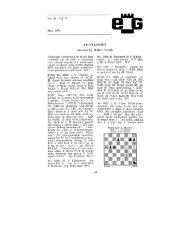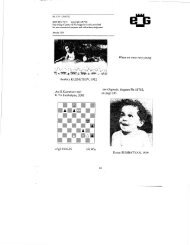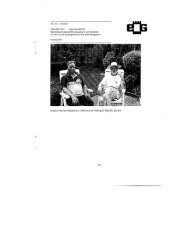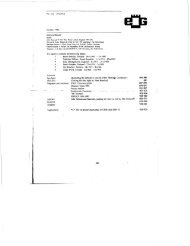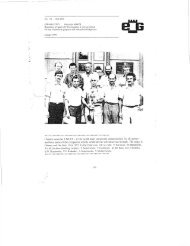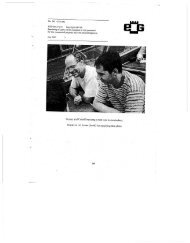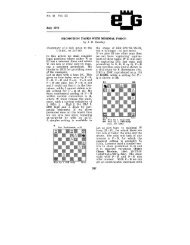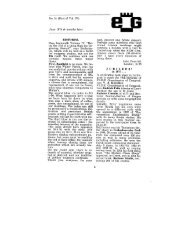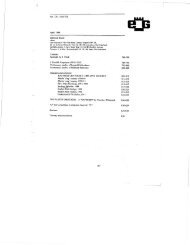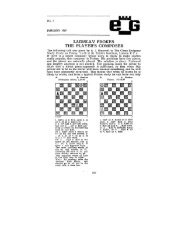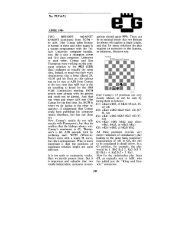EG71 - Gady Costeff
EG71 - Gady Costeff
EG71 - Gady Costeff
Create successful ePaper yourself
Turn your PDF publications into a flip-book with our unique Google optimized e-Paper software.
<strong>EG71</strong> (Volume V)April 1983PROFESSOR ALEXANDER HERBSTMANThe following is condensed from 2short articles by Alexander Hildebrandin the Swedish "Tidskrift forSchack"."It was an article by Herbstman inZadachy i Etyudy (probably in 1935)that my father gave me, that firstdrew me to studies, for the articledealt with how to compose them.Later, on my arrival in Sweden (frommy native Estonia), I published manyin TfS, and in the 1950s a correspondencewith Professor Herbstman beganand continued through the 60s.His letters were full of interest, andeven when critical they were positive,such as when he pointed out that oneof my compositions was not original,but had already been done by Troitzky.After a while we created somejoint compositions. When I visitedhim in Leningrad in the late 60's hewas very busy with marking examinations,and his wife said that therewould be only a couple of hoursavailable for me. In fact I arrived at 7o'clock in the evening, and stayed,having both tea and dinner, until 2 inthe morning. As a gift he gave me hispocket chess set, and we talked, surroundedby his extensive library,about many things, including Russianliterature. The professor asked whoin my opinion was the best of contemporaryRussian writers, andwithout hesitation I replied: "Solzhenitsyn",although I knew that hehad lost his popularity with theauthorities by then. The professorsaid nothing, but embraced me andsaid: "Dear Alexander, please choosea book, whatever you wish, from myshelves, and it is yours." For a longtime I looked, until I found a title intwo copies. "That one", I said,knowing that I was not taking somethinghe could not replace. ... Ourcorrespondence lapsed, then I receiveda letter from Vienna. It was thespring of 1980, and the professor andhis family had left the USSR. Aftersome time he managed to come toSweden. In September, my wife and Imet him at Arlanda airport.We saw an old man with a walkingstick and something of a stoop, andwhile the baggage was being dealtwith by his wife and daughter herecited Heinrich Heine in German.Since that moment we spent manyevenings together discussing not justchess, but literature; of which he hada most deep knowledge, naturally ofRussian writers like Pushkin andLermontov, but also of German,English, French, Spanish and Italianauthors. And he had personal memoriesof Mayakovsky, Yesenin, Mandelshtam,Balmont, Brussov andothers of the Russian Parnassus.All his knowledge and more he hastaken with him, but his legacy in theform of his writings and studies willremain as long as there are chessenthusiasts."Herbstman was one of the 6 composersin the initial award of InternationalMaster of Chess Compositionby FIDE in 1959. In his com-121
posing life he produced about 350studies, winning about 150 prizes, 20of them First Prizes. He wrote 10books in Russian, of which 4 weretranslated into Dutch and 2 intoGerman.NlJ.J. van den EndeTijdschrift KNSB, 1935AJR adds: I too experienced theHerbstman family hospitality in Leningrad,in the autumn of 1979. Althoughthey were on the traumaticbrink of departure they made sure Isaw all the principal sights of thebeautiful northern city, not omittinga visit to the opera, where we saw aversion of Gogol's prose work "DeadSouls". My memories are, likeAlexander Hildebrand's, full.CORRECTING UNSOUND STUDIESby IGM John Nunn, LondonReaders will already be familiar withmy tendency to demolish studies (seeEG61), so to redress the balance Ihave decided to write a little aboutthe reverse process - correcting demolishedstudies. This is often lessdifficult than it sounds and in generalthe more complex the cook, the easierthe correction becomes. This is becausea complex cook requires everypiece to be on the right square for itto function correctly and the alterationof the position of almost anythingwill destroy the cook, so thewould-be corrector has considerablefreedom of action. A simple cook isoften much harder to correct, since ifit does not occur the very beginningof the study it may well be inherent inthe idea the composer is trying toexpress and in this case considerablemodification may be necessary.Here are three examples of demolishedstudies and suggested corrections.Readers are welcome to demolishthe corrections if they can! Thecooks and corrections are publishedhere for the first time.122Win 4 + 4Nl is reproduced as No. 4 in theappendix of '1234' and No. 1912 in'2545', for example, the composer'ssolution being 1. c7 Ba3+ 2. Kg8 b23. Bg6 Kxg6 4. c8 = Q bl=Q 5.Qg4+ Kh6 6. Qh4+ Kg6 7. Qh7 +and wins. There is a cook by 3.c8 = Q bl=Q 4. Qd7 (threateningQg7 mate and if 4. ..., Kg5 5. Qg4 +mates) Qgl + (4. ..., Qb3+ 5. Kh8 ismuch the same) 5. Kh8 (threat 6.Qh7+ Kg6 7. Qg6 + ) Bc5 (or 5. ...,Qg3 6. h4) 6. h4 and Bl is threatenedby mate on h7 as well, which provesimpossible to stop. Here the problemis wPh3, which prevents bK's escapevia g5 after 4. Qd7. However it doesnot good to simply remove this pawn,for then there is a cook by 3. c8 = Qbl = Q 4. Qh3 + Kg5 5. Qg3 + . Whatabout replacing the wP on h3 by a bPon h4? Then both cooks are preventedbut it is doubtful if W can winafter 3. Bg6 Kxg6 4. c8 = Q Kg5.However adding wP almost anywherecures this problem so replacing wPh3by wPh2 and bPh4 seems to correctthe study.N2 is very well known (No. 173 in'1357' amongst other places) and thecomposer's solution runs 1. Bbl f4 2.Kc6 f3 3. Kc5 Kb3 4. d7 f2 5. d8 = Qf 1 = Q 6. Qd5 + Kc3 7. Qd4 + Kb3 8.Qa4+! Kb2 9. Qc2+ Kal 10. Qa2mate. The cook is 3. d7 f2 4. d8-Qfl =Q 5. Bc2+ Kb4 6. Qd2+ Kc4 7.Be4 Kb3 (or else Bd5 mate) 8. Bd5 +
N2TB. GorglevVTsSPS Chess Club Ty, 1938Win 3 + 5Ka4 9. Qc2+ Kb4 10. Qb3 mate.Here bPf6 is the problem, preventing..., Qf6+ in reply to 7. Be4, but onceagain we cannot simply remove itsince then here is a cook by 1. Bd5 f42. Kc6f3 3. d7f2 4. d8 = Qfl=Q 5.Qh4 +, but we can move the f6 pawnto g5. This still blocks the h4-d8diagonal so both cooks are preventedand the solution remains the sameapart from the extra variation 1. Bb 1g4 2. Kc6 g3 3. Bc2 + Kb4 4. d7 a2(4. ..., g2 5. d8 = Qgl=Q 6. Qd2 +Kc4 7. Qd3 + Kb4 8. Qb3 mate) 5.d8 = Q al=Q 6. Qd6 + with mateafter 6. ..., Kc4 7. Qc5 or loss of thequeen after 6. ..., Kc3 7. Qe5 + .two problems in this solution. Firstly,the initial position is a draw as Bl canimprove by 3. ..., axb5! 4. Ra8+ Kb45. Rxal Kc3 6. Rhl Kxc2 7. Rxh2 +Kc3 drawing. Secondly, W has analternative win later by 5. Rc6 (or d6or f6) which actually just forces matesince Bl cannot meet the threat of 6.Rc4 + Kb3 7. Rb3 + Ka2 8. Ra4 mate- if 5. ..., Ka3 6. Rb3 + Ka2 7. Rc4mates all the same. However Kasparianin his book Remarkable Studies(1982), gives a different position inwhich there are additional pawns,wPf2andbPh3.Presumably this was a correction tothe position given above. This revisedposition won first prize. Unfortunately,although this solves the problemof Bl's 3. ..., axb5! it does nothingabout the cooks by 5. Rc6/d6/f6. Thisproblem is obviously inherent in thematrix so I suggest N4 as correction,in which the cook has become thesolution:N4Version of N3N3Sach, 1944WinN3 is as given by Mikan in his 1975book on Havel. The intended solutionis 1. R5b6+ Ka5 2. R6b7 a6 (2. ...,Ka6 3. Ra8) 3. Rb5 + Ka4 4. R5b6 a5(4. ..., Ka5 5. Rxa6 + Kxa5 6. Ra8 + )5. Rb4+ Ka3 6. Rc4 (threatening 7.Rb3 + and 8. Ra4 mate) a4 7. Rxa4 +Kxa4 8. Ra8 + and wins. There are1. R5b6+ Ka5 2. R6b7 a6 3. Rb5 +Ka4 (3. ..., axb5 4. Ra8+ Kb4 5.Rxal Kc4 6. Rel Kxd4 7. Rxe2 b4 8.Kc7 Kc4 9. Re4 + wins) 4. Rb6 a5 5.Rc6(5. Rb4 + ?axb4 6. Ra8 + Kb5 7.Rxal Kc4 8. Rel b3 and W had bettertake the draw by 9. Rxe2 bxc2 10.Rxc2 Kxd4 since he might even loseafter 9. cxb3 + ? Kd3!) el=Q 6.Rc4 + Ka3 7. Rb3 + Ka2 8. Ra4 mate.This version gives up one wR sacrifice,but at least it seems to be correct.123
+ Alexander Petrovich KUZNET-SOV (1913-1982). After a protractedillness this prolific Moscow composerhas died. As the notice in "64 -Shakhmatnoe Obozrenie" (No. 20 of1982) says, his many studies try toexpress unusual ideas, romanticideas, often at the expense of form,but giving his oeuvre a distinctiveflavour. He was a staunch supplier oforiginals to EG, often in conjunctionwith another composer. Before retirementhe was a gardener and decorator,with a fine collection of records(musical!) and most neat handwriting.ALP. Kuznetsov"64 - Sh. Obozrenie" x.821. ...,Bg4+ 2.Kd2b2 3.d7Sb3+ 4.Kel 4. Kc3? blS + 5. Kc2 Bdl+ . 4...., blQ + 5. Bel. 5. Kf2? Rb8. 5. ...,Qe4+. 5. ..., Rb8 6. d8Q+ Rxd8 7.Qf8 + Rxf8. 6. Be3 Qhl + . 6Rb8 7. d8Q + . 7. Bgl Qh4+ 8. Bf2Qhl + . 8. ..., Rb8 9. Qd5. 9. BglQe4+ 10. Be3Qbl + 11. Bel.G.M. Kaspaiyan1 Hon.Men., Shakhmaty v SSSR, 1938(First Half-Year)Black to Move, White DrawsWin 7+101. Qfl+ Kg3 2. Bf4+ Kxf4 3.Qxf2+ Ke5 4. Qh2+ f4 5. e3 Qh8 +(Kd6; Qxf4 + ) 6. Kg4 Qxh2 7. b8Q +d6 8. Qxb2+ Qxb2 9. d4 + Qxd4 10.ef mate.THEME: "Perpetual Pin of WPiece" - Earliest ExamplesG.M. KasparyanShakhmaty v SSSR, 1935Black to Move, White Draws1. ..., Se4+ 2. Kd7 Qg4+ 3. Kd8 b24. Rd7+ Kg6 5. c8Q. 5. Bxe4? Qxe4.5. ..., Qxg5 + 6. Re7 Qd2+. 6. ...,blQ 7. Bxe4 + Qxe4 8. Qc6 + . 7.Rd7 + Qa5+ 8. Rc7 blQ. 8. ...,Qg5 + 9. Re7, with "perpetual pin".9. Bxe4 + Qxe4 10. Qe6 + Qxe6 stalemate.Review "The Study Through theEyes of Grandmasters", by G.A.Nadareishvili, Moscow 1982, 208pages, over 300 diagrams, soft coverinRussian, edition 100,000.Chessplayers lap up the words anddeeds of their heroes, the over-theboardGrandmasters. The author,himself a Grandmaster of Composition,has conjured up 9 World Champions,from Euwe to Chiburdanidze,and 43 other Grandmasters, to commenton studies, on individual studiesselected by the author, two or threecomposers to each commentator. Toincrease the chances of this originalidea spreading the endgame studygospel, all the studies follow the"popular" mould defined by the124
author in 1976 (see EG48, p. 452): anaffinity to the practical game; aningenious main line; absence of distractinglycomplex side-variations; afinal move to crown the solution.Overall, a stunning collection ofstudies, with a wide variety of playercommentary,that should be a welcomepresent for any (and there aremany) Russian-reading chessplayer.As Botvinnik observes in the introduction,solving a study and findingthe best moves over-the-board bothinvolve the same mental process, sothere is obvious value in grandmasterlycomment on studies. It is truethat sometimes a composer may finda comment not to his taste, and Botvinnikaccounts for this by drawingattention to the differing views on theaesthetics of chess held by composersand practical players. This new-styleanthology is well-produced, wellindexed(by Grandmaster and composer),and can be repeatedly dippedinto at random and always withpleasure.AJRReview "The Development of theChess Study", by Filipp S. Bondarenko,Kiev 1982, 232 pages, 394 diagrams,soft cover, edition 165,000.The period covered by this, the 2ndvolume in Mr. Bondarenko's selflessand self-imposed task of recordingthe history of the study, is just thefirst quarter of the 20th Century. Thechapter headings are reminders ofwhat is probably familiar to manyreaders: "two giants (Troitzky andRinck) in creative combat"; "Tattersail'santhology"; "study tourneys atthe beginning of the century"; "retrogradeanalysis in the study"; "thestudy in various countries"; "the eveof the great expansion (ie the sovietera)". But the contents of thechapters put flesh on the familiarskeleton and, as the author remarks,take us back 60, 70 and 80 years,bringing those times alive. What isreally remarkable is the author'sachievement in bringing such variedinternational material together despitethe restrictions on research thatpractically all "eastern" authors haveto bear: specifically, no subscriptionsto foreign magazines or books, andno travel to the West, and no accessto Western libraries or private collections.Mr. Bondarenko has done hisbest to overcome these formidableobstacles by dint of extraordinarilypatient correspondence over a longperiod with many people, as listed inthe acknowledgements. How well hashe succeeded? Well, there is nothingto compare his work to, in either Eastor West. Therefore there is no waywe can give any final verdict except"very well indeed". In the absence ofany finally definitive "history of thestudy", we must be grateful for whatwe have - and deepen our knowledgeof the Russian language in order toappreciate the better this, still incomplete,fruit of Mr. Bondarenko'slabours. Volume 3 may be expectedin 1984 (approximately).AJRTourney awards due in 1983: theLommer Memorial and de FeijterJubilee are expected shortly. Both areformal. But the 4th tourney, informal,of Canadian Chess Chat hasbeen announced (for originals publishedin that magazine during 1983),without any award for the threepreceding tourneys having been published.The judge of the first tourney(1980), Attila Koranyi, completed histask and, presumably motivated byextreme frustration has published oneof the winners (4th Hon. Men., byJanos Mikitovics) in Magyar Sakkelet(ii.83). A letter of enquiry to the CCCeditor (J. Szarka) has not so farelicited any response.AJR125
DIAGRAMS AND SOLUTIONSNo. 4743A. AvniAl-Hamishmar, 25.iv.8O2nd Prize, Israel "Ring" Tourney, 1980No. 4742Y. HochShahmat, 19801st Prize, "Ring" Tourney, 1980Award: Haproblemai, xii.81en-prise move, nevertheless typical ofthis composer's distinctive style. 5...., Sg5+ 6. Kh6 Sf7+ 7. Qxf7 +Qxf7 8. Sg6+ Kg8 9. Bd5 Qxd5 10.Se7+ wins.No. 4742: Y. Hoch. Ofer Komai, theIsraeli champion solver and composer,was the judge. He comments thatthe general standard of the 28 entrieswas higher than that normally expectedfrom "ring" tourneys (ie, singletourneys with multiple sources, suchas newspaper chess columns). Severalanticipations were identified via MrHarman's services.1. Bb6+ ab 2. Rd8 Re5 + /i 3.Kxe5/ii alQ+ 4. Ke6 Qf6+ 5. Kxf6Bh4+ 6. Ke6 Bxd8 7. Kd7 Bh4 8.Kc7(c8) Ka6 9. Kb8 Bg3 + 10. Ka8draw.i) 2. ..., Ka6 3. Kxe4 Kb7 4. Rd7 +Kb8 5. Rd8 + , and not 4. Rdl? Bc3.ii) Else 3. ..., Ka6 to win simply onmaterial, and certainly not 3. Kf6?Bh4 + ."A study with a wealth of excitingelements. The position after 4. Ke6!!is magnificent, showing victory ofspirit over matter."No. 4743: Amazia Avni. 1. Sd5 +Kf8 2. Qxf6+ Sf7+ 3. Kh7 Qc2 + 4.Qg6 Qf5 5. Se7. A surprise putting-"A many-sided endgame incorporatingmany ideas, not all of which areoriginal, but which have neverappeared together before."No. 4744 Y. Afek and H. AloniShahmat, 19803rd Prize, Israel "Ring" Tourney, 1980No. 4744: Y. Afek and Hillel Aloni.1. Sc3 Bc6 2. Sa4+ Bxa4/i 3. Bb5Bxb5 4. Bc7 + Ka6 5. b8S mate, andnot 5. b8Q? Bc6 + .i) 2. ..., Kxa6 3. Sc5+ Kb6 4. Ba7 +Kc7 5. Sa6 + Kd6 6. Bd4."It is very attractive to see 3. Bb5!, aneat sacrifice for self-block purposessetting up an impressive mate."126
No. 4745ii. KosleffShahmat, 19804th Prize, Israel "Ring" Tourney, 1980n 5^5ft>w *5555^5^Rb6+ Kxb6 10. a5 + Kxa5 11. b4 +Kxb4 12. a3 + Kxa3 (or Ka5) 13. Ba4Kxa4 stalemate, and if bK declinesthe final offer, wB can occupy dl todraw, even after the loss of wPe6.i) 1. Ra6 + ? Kb8 2. Sc6+ Kc7 wins,ii) 2. ..., Ka6 3. Sb4 + Ka7. 2. ...,Kb6?3. a5+ wins.Hi) 3. ..., Kb8 4. Rc8 + Ka7 5. Rc7 +,repeating, and not 5. Ra8 + ? Kb6.No. 4745: G. Kosteff. 1. Bhl Bf3 +2. Kc5/i Bxhl 3. Bc7 Be7 + 4. Kb6Bd8 5. Ka7 Bxc7 stalemate.i) 2. Bxf3? Kxf3 3. a7 hlQ 4. a8QK + wins."Nice play by wK, who becomes thehero."No. 4747Y. HochShahmat, 19802 Hon.Men.,Israel "Ring" Tourney, 1980No. 4746V. AfekShahmat, 19801 Hon. Men.,Israel "Ring" Tourney, 1980No. 4748V. lanosi3 Hon.Men.,Israel "Ring" Tourney, 1980No. 4746: Y. Afek. 1. d7 g3/i 2.Qxg3 Qc4+ 3. Qc7 alS 4. d8S Qg4 +5. Qd7.i) 1. ..., Qc4+ 2. Qc7 Qg8 + 3. d8Swins."A pity that after 5. Qd7 the mainvariation ends in an 'artificial*manner, because on 5. ..., Qc4+ Whas 2 good answers."No. 4747: Y. Hoch. 1. Rc8 + /i Ka72. Sc6+ bc/ii 3. Rc7+ Kb6/iii 4.Rxc6+ Kb7 5. Rb6 + Ka7 6. Ra6 +Kb8 7. Rb6+ Kc7 8. Rc6 + Kb7 9.No. 4748: E. Janosi. 1. Kd2 h3 2.Bxh3 (Bf3? Bfl;) 2. ..., Bf5 3. Bxf5Bxb4 + 4. Kd3/i gf 5. d7 Ba5 6. Kd4Bc7 7. d6 Bd8 8. Kd5/ii Kg7 9. Ke6Kg6 10. Ke5 Bh4 11. Kd5 Bf6 12. Ke6Bd8 13. Ke5, draw. A final positionaldraw that Reti would have appreciated.i) 4. Ke3? gf 5. d7 Bc5 + 6. Kd3 Bb6.ii) 8. Ke5? Kg6 9. Ke6 Bf6 10. Kd5Kf7.127
No. 4749Y. HochJerusalem Post, 19801 Comm.,Israel "Ring" Tourney, 1980No. 4751Y.HochJerusalem Post, 19803 Comm.,Israel "Ring" Tourney, 1980WinNo. 4749: Y. Hoch. 1. Bxf4 + /i Kxf42. Sb4 R5xc6 + /ii 3. Ke7 (Sxc6?Rxd7;) Rxd7 + . Is there any alternative?If 3. ..., Rc5; 4. Sd3 + . 4. Kxd7wins by domination,i) 1. d8Q? R7xc6 + 2. Kg7 Rc7 + 3.Kxh6R7c6 + 4. Kg7Rc7 + .ii) Or 2. ..., R7xc6 + 3. Sxc6 Rxc6 +4. Ke7 Rc7 5. Ke8 wins."... the domination formed by thefinal 2 moves is very interesting."No. 4750Y. HochJerusalem Post, 19802 Comm.,Israel "Ring" Tourney, 1980No. 4751: Y. Hoch. 1. b4 b5/i 2. Ke3e5/ii 3. Kd3 Kbl. Not a typing error.4. a3/iii Kb2 (e6; Kc3) 5. a4 ba 6. b5a3 7. b6 a2 8. b7 alQ 9. b8Q + winsin standard manner (eventual Qb4 +,Ka2; Kc2).i)l. ..., Kb2 2. a4and3. a5.ii) 2. ..., Kb2 3. Kd4 Ka3 4. Kc5 Ka45. e5.iii) The point is shown by 4. a4? ba 5.b5 a3 6. b6 a2 7. b7 alQ 8. b8Q +Qb2.No. 4752Y. HochAI-Hamishmar, 5.xii.8O4 Comm.,Israel "Ring" Tourney, 1980No. 4750: Y. Hoch. 1. Rd3 + Kc4 2.Rxd4 + /i Kb3 3. Rb4 + Ka2/ii 4.Rxa4+ Kb3 5. Rb4+ Bxb4 6. Sa5 +Qxa5 7. Bd5 + Ka4 8. Bc6+ Kb3 9.Bd5 + .i) 2. Rc3 + ? Kb5 3. Sa7+ Kb4 4.Bxb5Bh6 + .ii) 3. ..., Bxb4 4. Sa5 + Qxa5 5.Bd5 -f Qxd5 stalemate.No. 4752: Y. Hoch. 1. Rg7 + Kf2(Kf3; Rg3 + ) 2. Rf4 + Ke2 3. Re4 +Kdl 4. Rd7 + Rd6/i 5. Rxd6+ Qxd66. Rel + Kc2 7. Re2 + /ii Kc3 8. Rc2 +Kb4 9. Rb2 + Kc5 10. Rc2+ Kb6 11.Rb2+ Kc7 12. Rc2+ Kd8 13. Rd2Qxd2 stalemate, and not 13. Rc8-r-?Ke7 and Bl wins.128
i)4. ..., Kc2 5. Re2 + Kcl 6. Rel + ,for if 6. ...,Kb2 7. Rd2+.ii) See move 13. Not 7. Rcl+? andbK heads for d7, then e6.'The idea is very common, but 7.Re2 + !! makes it worthy of inclusionin the award."No. 4755D. Gurgenidzeand K.I.. Pogosyants(xi.79)3rd Prize, Scacco!, 1979No. 4753F.S. Bondarenko(xi.79)1st Prize, Scacco!, 1979Award: vii.81 and xii.81No. 4755: D. Gurgenidze and E.L.Pogosyants. 1. e8S+ Qxe8 2. gfBg3+ 3. Kgl Bf2 + 4. Kh2 Bgl + 5.Kg3 Bh2 + 6. Kf2 Bg3 + 7. Kgl.No. 4756J.M. Kapros(i.80)Hon.Men., Scacco!, 1979No. 4753: F.S. Bondarenko. Judgewas the Scacco! studies columnistand international over-the-boardMaster Dr Enrico Paoli. 1. Se6 eRxe62. d4+ fg 3. d5 Rxe7 4. dc g6 + 5.Kh6. There were no alterations to theaward during "confirmation time".No. 4754I). Gurgenidze(xi.79)2nd Prize, Scacco!, 1979No. 4756: J.M. Kapros (Argentina).1. Sxe2 fe 2. Bc4 elQ 3. Rc8+ Kg74. Rc7+ Kg6 5. Rc6 + Kg7 6. Rc7 +Kf8 7. Rf7 + Ke8 8. Rf 1 h5 + 9. Kh3,with domination (to draw) of bQ.No. 4757M. Malous(x.79)Commended, Scacco!. 1979No. 4754: D. Gurgenidze. 1. Rh4Qg8 2. Rh8 Qf7 3. Rf8 Qd7 4.Sxg6 + Ke6 5. Rf6+ Kd5 6. Rf5 +Kc6 7. Rc5 + dc8. Se5 +.129
No. 4757: M. Matous. 1. Se4/iRd4/ii 2. Rg4 Rxe4 3. Rxe4 Bf6 + /iii4. Kh5 d2 5. Rg4 dlQ(B) stalemate,i) 1. Rh5 + ? Kg6 2. Rd5 Bxc3, orhere, 2. Rg5+ Kf7 3. Se4 Rd4 4. Rg4Rxe4.ii) 1. ..., d2 2. Sxd2 Bf6 3. Se4 Rd4 4.Kg3, but not 4. Kh5? Rxe4 5. Rg4Re5 + .Re7 + and 5. Rd7.No. 4758H. Aloni andY. Hoch1st Prize, 60-year Anniversary of MongolianPeople's Republic Ty, 1980Award: "Mongolia", i.82 Correctionv) 7. Kf3? Kb5 8. Ke4 Kb6 9. Kd5Kb7 10. a4 Kb6 and W cannot win. 7.Ra8? Kb5-b6-b7.vi) 12. ..., Kc6 13. Rb8 Kc7 14. a7.12. ..., Kb5 13. Kd5.vii) 14. Kc4? Ka5 15. Kb3 Kb5. 14.Ke6? Kc7.No. 4759V. Razumenko2nd Prize,Mongolian Anniversary Ty, 1980No. 4758: H. Aloni and Y. Hoch.Judge: F.S. Bondarenko, assisted bythe "local" Mongolian composer S.Chimedtzeren. 1. Rbl/i Qxbl 2. gfQxh7/ii 3. g6 Qh8 4. Re4+ Kd2/iii5. Re8 Kc3 6. Kg2/iv Kc4 7. a4/v Kc58. a5 Kc6 9. a6 Kb6 10. Ra8 Ka5 11.Kf3 Kb6 12. Ke4 Kc7/vi 13. Kd5 Kb614. a7/vii Kb7 15. Re8 Kxa7 16. Kc6.i) 1. gf? Bd6+ 2. Kh3 Qxe3 + 3. Kg4Qe6 + 4. Qf5 Qe2 + 5. Qf3 Qe6 + .ii) 2. ..., Bd6+ 3. Khl Qdl 4. Qf5Ke2 + 5. Kg2 wins, but without thecorrection (wPh4 omitted from original)then there 2. ..., Bd6+ 3. KglBc5+ 4. Kg2 (Khl, Qdl;) 4. ...,Qb2+ 5. Khl Qcl, and there seems tobe no win.iii) 4. ..., Kf2 5. Re8 Kf3 6. Kh3 (a4?Kg4;)6. ...,Kf4 7. a4.iv) 6. Kgl(g3)? Kb3 7. Ra8? B + .And 6. Kh3 only lengthens thesolution.No. 4759: V. Razumenko. 1. Bc4Khl 2. Qbl+ glQ 3. Qxe4 + hQg24. Qh4+ Qlh2 5. Bxh2 Qc2 + 6. Kb5Qb2 + 7. Kc6 Qxh2 8. Bd5 + Kgl 9.Qel mate.No. 4760I). Gurgenidze3rd Prize,Mongolian Anniversary Ty, 1980No. 4760: D. Gurgenidze. 1. Rb2Rh8+ 2. Kxh8 hlQ+ 3. Kg7 Rxa3 4.Re8 + Ka7 5. Re7 + Ka6 6. Re6 +Ka5 7. Re7 Qa8 8. eRb7 Qa6 9. Rblg4 10. Re7 Qa8 11. eRb7 Qa6 12. Re7draw.130
o. 4761 E.L. Pogosyants4th Prize,Mongolian Anniversary Ty, 1980No. 4763I), (iurgenidze1 Hon.Men.,Mongolian Anniversary Ty, 1980No. 4761: E.L. Pogosyants. 1. h8QSg6+ 2. Bxg6 clQ 3. Qxf6 Qh6+ 4.Kg4 Qh3 + 5. Kf4 Qf3 + 6. Ke5 Bg77. Be4Bxf6 + 8. Kd5 draw.No. 4764O. Komai2 Hon.Men.,Mongolian Anniversary Ty, 1980No. 4762B. BuyannenekhSpecial Prize,Mongolian Anniversary Ty, 1980No. 4762: B. Buyannemekh. 1.Ra2+ Kbl 2. Re2 Qhl 3. Se4 Qdl +4. Kb4 Qd4+ 5. Kb3 Qd5+ 6. Kc3Qxe4 7. Rel + Ka2 8. Re2+ Ka3 9.Ra2 + Kxa2 stalemate.No. 4763: D. Gurgenidze. 1. cRd8 +Kc5 2. Re5+ Kc4 3. Rc8 + Kd3 4.Rd5 Ke4 5. Rd7 dlQ 6. Re8+ Kf5 7.Rf7 + Kg5 8. Rg8 + Kh5 9. Kh8.No. 4764: O. Komai. The readersolverin a hurry may well overlookthat Bl threatens mate in 1 by Sb6!1. Sg6+ Kg3/i 2. Rg2+ Kxg2 3.Sf4 + Kf2/ii 4. Sd5 blS (blQ; Ba4)5. g8S (g8Q? Sc3;) 5. ..., Sc3 6. gSxe7Kel/iii 7. Bc2/iv Kd2 8. Bb3 h4 (Kcl;h4) 9. Bdl Kcl 10. Bb3 Kb2 11. BdlKa3 12. Bc2 drawn.i) 1. ..., Kg5 2. Rg2 + Kh6/v 3.g8S + Kh7 4. Sf8+ Sxf8 5. Bxe7 blQ6. Sxf6+.ii) 3. ..., Kfl 4. Sd5 blS 5. Ba4 Sc3 6.Sxe3+ and Bxd7. If 3. ..., Kh2(hl)see main line.iii) Zugzwang. 6. ..., Sxdl 7. Sg8 Sc38. gSxf6 and 9. Be7. Or 6. ..., Kg3 7.Bc2Kxh3?8. Sf4 + andeSd5.iv) 7. h4? Kd2 8. Bb3/vi Kcl 9. BdlKb2. Or 7. Bb3? Kd2 8. Bdl h4.v)2. ..., Kxf5 3. Bc2+ Ke6 4. Sf8 + .vi) 8. Bc2? Kxc2 9. Sxe3 + Kb3 10.S7d5 Sa4.131
No. 4765E. Melnichenko3 Hon. Men.,Mongolian Anniversary Ty, 1980No. 4766V.N. Dolgov4 Hon.Men.,Mongolian Anniversary Ty, 19808 + 7 8 + 9No. 4765: E. Melnichenko. 1. Sc3Rc2/i 2. Bel Rcl/ii 3. Bd2/iii Rc2 4.Sbl Rb2 5. Bd3 Rb3 6. Bc2 Rb2 7.Sa3 Ra2 8. Bcl/iv.i) W is a piece up and threatens todisentangle his men by e4, followedby Ke3, among other manoeuvres. SoBl's forcing double attacking threatsare themselves forced,ii) 2. ..., Rxc3 3. Bxc3 Sd5+ 4. Ke5leaves W the exchange ahead, to winby technique (however tough),iii) 3. Bdl? Sd5+ 4. Sxd5 Rxdlrecovers the piece, to draw, on thereasonable-looking assumption that5. Sxe7 to win a P is not enough forW to win. Indeed, the composercarefully gives 5. ..., Kxe7 6. Bh4 +Ke6 7. e4 Rd3, when one might go on8. Bf2 f6 and we are convinced,iv) This wins, because 8. ..., Ral ismet most easily by 9. Bb2 Ra2 10.Sc4, though the composer gives 9.Bbl Sd5+ 10. Kg3 (or Ke4) Sc3 11.Bb2, after which W has to make doagain with an "exchange-ahead"win.No. 4766: V.N. Dolgov. 1. e8S Sxe8(Se6; d8S) 2. feS Bxe8 3. deS Rxh7 4.Sc7 + Rxc7 5. dc alQ (Rf8 + ; c8Q) 6.Ka8 Rf8 + 7. b8S + Rxb8 + 8. cbSmate.No. 4767AI.P. Kuznetsov5 Hon.Men.,Mongolian Anniversary Ty, 1980DrawNo. 4767: ALP. Kuznetsov. 1. Bf 1 +Kc6 2. Bg2 + Kd7 3. Bh3 + Ke8 4.Bg4 and the following lines: 4. ...,Kf7 5. Bf3 alQ 6. Bd5+ Kg6 7.Be4+ Kh5 8. Bf3 + , perpetual checkon bK's "diagonal" e8-h5, and if,here 5. ..., Ke6 6. Bg4+ Kd5 7.Bf3 + Kc4 8. Be2 + Kb3 9. Bdl +Kc4 10. Be2 + Kd5 11. Bf3 + Ke6 12.Bg4 + and perpetual check on bK's"diagonal" b3-e6, while if 12. ...,Kf7 13. Bf3 gives a positional draw.4. ..., alQ 5. Bh5+ Kd7 6. Bg4 +Kc6 7. Bf3 + Kb5 8. Be2 + , withperpetual check on bK's "diagonal"b5-e8.132
o. 4768 V.Evreinovand G.A. Nadareishvili6 Hon.Men.,Mongolian Anniversary Ty, 1980No. 4770L. Togo-okhuuSpecial Hon.Men.,Mongolian Anniversary Ty, 1980No. 4768: V. Evreinov and G.A.Nadareishvili. 1. f7 Bd6+ 2. Bxd6elQ + 3. Kf8 Qb4 4. Bxb4 blS 5.Bd6 alB 6. Ke8 f 1Q 7. f8Q + Qxf8 +8. Kxf8 Sd2. This is to meet thethreat of Kf7, Bf8 and Bg7+ withthe counter Sd2-f3-g5 +. So W has togo for bPa7 to secure the draw. 9.Bc5 Sf3 10. Bxa7 Bd4 11. Bxd4 +Sxd4 12. a7 and the solution stopshere, though it might continue 12. ...,Se6+ 13. Ke7 Sc7 14. Kd6 Sa8 15.Kc5 Kg8 (b4? Kxb4, or Sc7? Kc6) 16.Kxb5 Kf7 17. Kc6 Ke7 18. Kb7 Kd719. Kxa8 Kc7(c8) stalemate.No. 4770: L. Togo-okhuu. 1. Kd6alQ 2. Kc6+ Ka8 3. Qg2 Qf6 + 4.Kc7 + .The next position in the award, by A.Chernenko, is identical to No. 4757by the same composer, who wasclearly unaware of its "reserve"status in the Finnish tourney...No. 4771E. Melnichenko2 Comm.,Mongolian Anniversary Ty, 1980No. 4769V. Kalandadze7 Hon.Men.,Mongolian Anniversary Ty, 1980No. 4769: V.I. Kalandadze. 1. RblaRxbl 2. a7 aRfl + 3. Ke8 Rel + 4.Kd8 Rdl + 5. Kc8 Rcl + 6. Kb8 Kb67. a8Q Rxh7 8. Qa7+ Rxa7 stalemate.No. 4771: E. Melnichenko. To drawW has to rid himself of wR and wQwhile not allowing mate on the h-file,and (later on this will becomeapparent) not allowing Bl to lift thestalemate (eg by B(Q)xg2 + ;). However,1. Rdl + ? is a bad error, asmate on the first rank is inevitableafter 1. ..., cdQ. The clue to the firstmove is that wQ can check on blafter bPc2 has promoted. 1. Qg6/iQd5 2. Rxd5 Bxd5 3. Qe4 (Qf5? Bf3;)3. ..., Bb7 4. Qc6 d6 5. Qe4 Bc3 6.Qc6Bb2 7.Qe4draw.i) 1. Rc4? Qxc4 2. Qe5 Qxe2 wins.133
No. 4772AI.P. Kuznetsovand V.I. Neisbtadt3 Comm.,Mongolian Anniversary Ty, 1980No. 4772: ALP. Kuznetsov and V.I.Neishtadt. 1. h8S + /i Rxh8 2. f8S +Rxf8/ii 3. Qf5 + Kf7 4. Qe6 4* Kg6 5.Qf5+ Kxf5 6. bcB + (bcQ + ? Bd7;)6. ..., Kg6 7. Bf5 + Kf7 8. Be6 +Kxe6 9. c8B + Bd7 stalemate.i) 1. feQ + ? Rxe8 2. bcQ Rxc8 + 3.Qxc8 clQ 4. h8S + Kh7 5. Qf5 + g6.1. Qxc8? clQ 2. Qf5 + /iii Kxf7 3.Qe6+ Kg6 4. Qf5 + Kxf5 5. c8Q +Bd7 wins.ii) 2. ..., Bxf8 3. Qxe8 + Kh7 4. bcQg6 5. cQd7 + Bg7 6. Qxh8 + Kxh8. 7.c8Q + Kh7 8. Qf7.iii) 2. feQ + Rxe8 3. Qxe8+ Kxh7 4.Qg8 + Kxg8 5. c8Q+ Qxc8 + 6.bcQ + Qd8.mate can come to his rescue if onlyhe can rid himself of bQ. Meanwhile,wK is also vulnerable, either to bQmating on the a-file, or to bR, shouldW raise the stalemate and allowbBg8-h7; after which bRh8 is poisedto deliver mate. So, there follows 2...., Qel 3. Rdl (Rc2? be;) Qfl 4. Rel(Rd2? Qg2; or Rd4? Qh3;) Qgl 5.Rfl Qxg5. Bl would instantly loseafter 5. ..., Qxfl 6. Rxfl alQ+ 6.Bxal b2 7. Rhl mate, and no better is5. ..., Qh2 6. Rhl Qh5 7. aRgl. 6.Rhl + Qh5 7. Rxh5 + gh 8. RglalQ+ 9. Bxal Kh6 10. Bb2 Bh7 11.Bel mate.o. 4774 G.N. Zakhodyakin5 Comm.,Mongolian Anniversary Ty, 1981No. 4773E. Melnichenko4 Comm.,Mongolian Anniversary Ty, 1981WinNo. 4773: E. Melnichenko. After 1.Sg5 + Bxg5 2. hg, bK is, of course,vulnerable on the h-file, but stale-No. 4774: G.N. Zakhodyakin. 1. Bc4Qa4 2. Bb3 Qc6 3. Bd5 Qg6+ 4. Bf7Qc6 5. Bd5 Qb5 6. Bc4 Qh5+ 7. BflQb5 8. Bc4 and Bl is beginning tomove round in square circles. At leastI thought that was the solution (nonein my source) but 3. Bd5? is wrongon account of 3. ..., Qg6+ 4. Bf7Qe4+ followed by ... Bf6; to win.So, as Mr Emil Melnichenko pointsout (I had asked him to solve thestudy), the correct solution runs 3.Be5 Bxe5 4. Bd5 Qg6+ 5. Bf7 Qc6 6.Bd5 Qa4 7. Bb3 Qe4 8. Bd5 draws,and not, of course 8. d8Q? Bf6 + .One always thinks highly of a studywhose solution has defeated one ...but this really is neat.134
OriginalD.R. CodesDraw 8 + 7No. 4775: D.R. Godes (Ryazan, USSR).1. f7 Bxf7 2. Bxf7 e4 3. Rd7 h2 4. Bg6Rh4 5. Rh7 hlQ 6. Bxe4+ Rxe4/i 7.Rxhl Kxhl 8. f4 Kg2 9. Kd3 Rb410. Kc3Re4 ll.Kd3draw.i)6...., Kfl 7. Bxhl Rxh7 8. Bc6Kxf29.Bxb5 Rh3 10. Bc4 Rxe3 11. b4 e5 12. b5draw.No. 4776V.Kos1st Prize,Heuacker Memorial Tourney, 1981Provisional award:Die Schwalbe, x.81 (and ii.82)The administration of this tourneywas upset, first by the death of itsoriginator (Joachim Reiners) andthen by confusion over closing dates,while some entries went astray.Finally, the provisional award appearedwithout any solutions, makingnonsense of the three months' confirmationtime. 24 diagrams (notsolutions) of Heuacker's studies appearedin the xii.81 issue of DieSchwalbe.INo. 4777V. Shanshin2nd Prize,Heuacker Memorial Tourney, 1981No. 4776: V. Kos (Czechoslovakia).Judge: A.J. Roycroft, who had 20entries to examine. Anticipations(thanks to Mr Harman) and analyticalsuspicions reduced the field to 9,whose ordering caused few headaches.For a tourney of this smallentry the standard was satisfactory.1. Sg6+ Kf7 2. Sh8 + Ke6 3. Se4Bel + 4. Kc4 Ke5 + 5. Kd3 Bh7 6.Sf7+ Kd5 7. Sg5 fg 8. Ke3 and toavoid 8 Bxe4 stalemate. Bl musteither lose bPg5 or allow Sf6 + ."Apart from wPe2, every manmoves, transforming the whole lookof the position, by dint of a series oflittle tactical points, into an unexpectedmidboard stalemate."No. 4777: V. Shanshin (Omsk,USSR). 1. Sd2/i b2 2. g6 Re5+ 3.Kf7 Rd5 4. Sbl Rdl 5. Sc3/ii Rf 1+6. Ke7 Rcl 7. Sb5+ Kb7 8. Sa3 Ral9. g7 Rxa3 10. g8Q Rxe3 + /iii 11.Kf6(f8) blQ 12. Qd5+ Kb8 13.Qd8+ Ka7 14. Qa5 + /iv 14. ..., Kb715. Qd5 +, positional draw.i) 1. Sc3? Rxg5. 1. g6? Re5 + and 2...., Rxe4.ii) The composer clearly intended 5.Sa3 to fail, but seems not to haveprovided the demonstration.iii) 10. ..., blQ 11. Qd5+ Kc7 12.Qc5 + , or 11. ..., Kb6 Qd6 + , or 11...., Kb8 12. Qd6 +, or 11. ..., Ka612. Qa8 + , or 11. ..., Kc8 12. Qc6 +Kb8 13. Qd6 + .iv) 14. Qd4 + is a dual, unless wK ison f6, so the W choice on move 11 isa flaw."wS fights a cunning action againstbR + bP, and as a quite unexpectedconsequence the draw arises by aspecial kind of perpetual check."135
No. 4778V. Kos3rd Prize,Heuacker Memorial Tourney, 1981iii) For stalemate by 6. Rg7+ 7. Kh8Rh7 + 8. Rxh7, while if 6. Rd8?Re8 + stalemates again."The four-Rs ending is handled witha light touch, with the defence onlyjust losing the exciting doubles tennisrally!"No. 4780Y. Akobiya2 Hon. Mention,Heuacker Memorial Tourney, 1981Black to Move, White Draws 5 + 5No. 4778: V. Kos. 1. ..., Bb7+ 2.Bc6/i Sxc6 3. Sxg6 Se5+ 4. e4Bxe4-f 5. Rg2 Sg4 6. Sh4 Sf4 7. KglSh3+ 8. Khl Se3 9. Sf5 Sxg2 10.Sg3 + draw.i) 2. Rg2? loses because after, forinstance, 2. ..., Bxg2+ 3. Kxg2 Sxb54. Sxg6 Kxg6, when eP is blocked onits 4th or 5th ranks, with a win "byTroitzky"."Great care and ingenuity are neededto disentangle the main line from itswrappings. Missing only is an unequivocalneat end."No. 4779V. Pachman1 Hon.Mention,Heuacker Memorial Tourney, 1981Black to Move, White Draws 5 + 4No. 4780: Y. Akobiya (Tbilisi, USSR).1. ..., Sf3+ 2. Kg2/i Bxe7 3. Bxe7(Kxf3? Bxb4;) 3. ..., Sel 4- 4. Kf2(Kfl? Rhl-f-;) 4. ..., Sd3 + 5. Ke2Scl + 6. Kd2 Sb3+ 7. Kc2 Sal + 8.Kb2 Kxe7 9. Kxal Kd7/ii 10. b6/iiiRe5 11. Kb2 (Ka2? Kc6;) 11. ..., Kc612. Sa6 Kb5 13. b7 draws, but not 13.Sb8? Re7.i) 2. Kh3? Bxe7 + 3. Kg4 Rh4+ .ii) 9. ..., Kd6 10. Se8+ Ke7 11. Sc7.iii) 10. Sa-? Rxb5 11. Ka2 Ra5 + ."wK is teased across the board by bSso that bR looks like winning againstthe badly placed wS 4- wP, but aconcluding finesse finds the draw."No. 478!I.M.Carayeli3 Hon.Mention,Heuacker Memorial Tourney, 1981No. 4779: V. Pachman (Czechoslovakia).1. Rh7/i Kg6 (Ke6; Ra8) 2.Rg7+ Kxh6 3. f4 Rh4/ii 4. Rh7 +Kg6 5. Rxh4 f6/iii 6. Rxf6+ Kxf6 7.Rh6 mate.i) 1. Kh7? Rel for ... Rxh6 + . 1. f4?Kg6.ii) Because 4. Kh8 followed by Rh7 +or fRg8 was threatened.136
No. 4781: I.N. Garayeli (Sumgait,USSR). 1. ..., Qh8+ 2. d4 Qxh5 3.Rf6/i Qe2 4. Rfl + Qxfl 5. Bxfl b26. Bd3 ed 7. c5 Kbl 8. Kb3 Kcl 9.Kc3 Kbl 10. Kb3 draws, or 9. ...,blBlO. Kb3Bc2 + ll.Kc3.i) 3. Bxe4? Qdl 4. cd cd, or 4. Rg2de.Contortions can have their compensations!"No. 4782J. Vandiest1 Comm.,Heuacker Memorial Tourney, 1981Bc5 Qe4 19. Kb7 Qh7+ 20. Kb8Qh2+ 21.Bd6Qe2 = )Ke8 ll.Qg6 +Ke7 (11. ..., Kd8 12. Bf6 + Kc7 13.Be5 + Kd8 14. Qf6+ Ke8 15. Bd6and 16. Qe7 or Qf8 mate) 12. Bf6 +(12. Bc5 + ? d6) Kd6 13. Bg7 + Kc5(13. ..., Ke7 14. Qf6 + Ke8 15. Qf8mate, or 13. ..., Kc7 14. Qb6 + Kc815. Qc5+ Kd8 16. Bf6 + Ke8 17. Qe7mate) 14. Qb6+ Kc4 15. Qb5 mate,iv) 9. ..., Kh7? 10. Qf5+ Kg7 11.Bd4 + Kh6 12. Qf6+ K- 13. Qh8 + .v)ll.Bc5 + ?d6 12. Qe5 + Kf7 = .vi) 13. Bf6? Qfl + 14. Kb6 Qf2 + 15.Kb7 Qc5, or 15. Kb5 Qe2 + 16. K-4?Qe4+.vii) 16. ..., Qg- 17. Qe8 + , etc.; - 16....,Qh6 17. Qe8+ Kh7 18. Qf7 + , or17. ...,Qf8 18. Qg6+.viii) 17. Kb-? Qbl + and 18. ..., Qg6,or 17. Ka7? Qgl + and 18. ...,No. 4782: J. Vandiest (Belgium). 1.f6 h3 2. f7/i h2 3. f8Q + Ke2 4. Bxe3hlQ 5. Qf2 + Kd3 6. Qd2 + Ke4/ii 7.Qd4+ Kf5 8. Qf4 + Kg6/iii 9. Qg5 +KH/iv 10. Qf5 + Ke7 11. Bg5 + /v,and now:A) 11. ..., Ke8 12. Qg6+ Kf8 13.Qf6 + /vi Kg8 14. Qd8+ Kf(g,h)715. Qe7 + Kg8 16. Bf6 Qfl+/vii 17.Ka5/viii Qg2(gl) 18. Qe8 + Kh7 19.Qh8 + ,B) 11. ..., Kd6 12. Qf6 + Kc5/ix 13.Be3+ Kb(c)4/x 14. Qd4 + Kb3 15.Qd3+ Kb4/xi 16. Kb6/xii d6 17.Bd2 + Ka4 18. Qc2+ Ka3 19. Ka5Qe4 20. Bel mate.i) 2. Bxe3 + ? Kxe3 3. f7 h2;- 2. Bf4?h2 3. Bxh2-e2.ii) 6. ..., Kc4? 7. Qc2 + Kb4 8. Bc5mate.iii) 8. ..., Ke6 9. Bd4 (Thr. 10. Qf6mate) Ke7 (9. ..., d6 10. Qf6 + Kd711. Qf7 + ) 10. Qf6 + (10. Bc5 + ? d611. Qxd6 + Kf7 12. Qf4 + Kg6 13.Qg4+ Kf6 14. Bd4 + Kf7 15. Qf5 +Ke8 16. Qe6 + Kf8 17. Qf6 + Ke8 18.ix) 12. ..., Kc7 13. Qb6+ Kc8 14.Qc8 mate.x) 13. ..., d4 14. Qxd4+ Kc6 15.Qb6+ Kd5 16. Qb7 + .xi) 15. ..., Kb2 16. Bd4+ KclQc3+ K-l 18. Qal + .17.xii) 16. Bd2 + ? Kc5 17. Qc3+ Kd618. Bf4+ Ke6 19. Qe5+ KH 20.Qf5+ Ke7."In this kind of endgame it is thequiet moves that impress here it is 17.Ka5!inLineA."137No. 4783E. Asaba andI. Lakhkov2 Comm.,Heuacker Memorial Tourney, 1981No. 4783: E. Asaba and I. Laichkov(Moscow). 1. a7/i Bh3 + /ii 2. Kel
Rg2/iii 3. Qc6+ and now 2 variations:3. ..., Kf7 4. Qd5+ Ke7/iv 5.Qe4+ Kf7 (Kd6; Qd3 + ) 6. Qd5 +Kg7 7. Qe5+ Kg6 (Kg8; Qd5 + ) 8.Qe8 + /v Kg7 (Kh7; Qh5 + ) 9. Qe5 +Kg6/vi 10. Qe8+ Kg7 11. Qe5 + .3. ..., Kf5 4. Qc5 + Kg6 5. Qc6 + Se6(Kg7; Qc3 + ) 6. Qe8 + Kg7/vii 7.Qe7+ Kg6 8. Qe8 + .i) 1. Kel? Ra2 2. a7/viii Rxa7 3.Qb2+ Kf7 4. Qxh2 Ral + and 5. ...,Ra2 + .ii) 1. ..., hlQ+ 2. Qxhl Rdl + 3.Kf2 Rxhl 4. a8Q Rh2 + 5. Kgl Rh8?6. Qal +.iii) 2. ..., Bg2 3. a8Q hlQ + 4. Kxd2Bxb7 5. Qxf8 + .iv) 4. ..., Kg6 5. Qg8 + . 4. ..., Se6 5.Qh5 + and 6. Qxh3.v) 8. Qe4 + ? Kh6 9. Qc6 + Sg6.vi) 9. ..., Kh6? 10. Qg5+ Rxg5 11.fg + and 12. a8Q.vii)6. ...,Kf5 7. Qf7 + . 6. ..., Kf6 7.Qh8 + .viii) 2. Qc6+ Se6 3. Qc3 + Kf7 4.Qf3hlQ+ 5. Qxhl Ral + ."The two perpetual checks are spicedwith a sudden sacrifice of wQ in note(vi)."No. 4784B. Neuenschwander3 Comm.,Heuaeker Memorial Tourney, 1981No. 4784: B. Neuenschwander (Switzerland).1. Qe5+ Kb7 2. Qe4 +(ba + ? Kxa6;) 2. ..., Kb8 3. Qf4 +Kb7 4. Qf3 + Kb8 5. Qg3 + Kb7 6.Qg2+ Kb8 7. Qh2 + 8. Qhl + 9.Qh8+ 10. ba + Sxa6 11. Qhl + Kb812. Qh2 + and a reversed staircase138movement until 18. Qe5+ Kb7 andnow the snap 19. Qb5 mate."wQ darts and flits like a wasp ~ andstings with a mate."No. 4785B. Breider(Original) Correction of No. 3559 inEG55Draw 4 + 5No. 4785: B. Breider.1. b7/i Rb6 2. ed/ii cd/iii 3. Bxd5Sb4 4. Kc7/iv Sxd5 + /v 5. Kc8 Rc6 +6. Kd8/vi Rd6 + 7. Kc8 Se7 + 8. Kc7Rc6 + 9. Kd7/vii Rb6 10. Kc7.i) 1. ed? Rxb6 2. dc/viii Sb4 3. c7Sc6 + 4. Ke8 (4. Kd7 Se5 + 5. Ke8Sxf7) 4. ..., Sa7 5. Bd5 Ke5 6. Bg2Kd6 7. Kd8 Rb2 8. Bh3 Rh2 wins.ii) 2. Kc7? Rxb7+ 3. Kxb7 KxH andBl wins.iii) 2. ..., Rxb7 3. dc Rb8+ 4. Kd7Sb4 5. c7 Rb7 6. Kd6=. Or 2. ...,Sb4 3. dc Kxf7 (3. ..., Sxc6+ 4. Kc7Ra6 5. Bc4) 4. c7 Sc6+ 5. Kd7 Se5 +6. Kc8/Kd8 = .iv) 4. Kd7? Sa6 and wins, for ex.: 5.Bg2 Ke5 6. Bfl Rd6+ 7. Kc8 Rc6 +8. Kd- Sb8.v) 4. ..., Rb5 5. Bc4 Sa6+ 6. Kc6Rc5+ 7. Kb6 = ,or if 5. ..., Rc5+ 6.Kb6Rc6+ 7. Kb5 = .vi)6. Kd7? Rc7+ wins.vii) 9. Kd8? Rcl 10. b8Q Sc6+ wins.viii) 2. Kc7 Kxf7 3. dc Rbl 4. Kd6Sb4 5. c7 Rcl 6. Kd7 Sd5 wins.No. 4786: J. Vandiest. The story, inbrief, is that Ramos' Nr. 3992 wasunsound, and corrections were publishedby the composer (in Proble-
No. 4796J. Vandiestdedicated to F. Moreno RamosDraw 6 + 4mos of vii-ix.80) and by Mr. Vandiest(No. 4308), but arising out of all thiswork the present related dedicatorycomposition now graces EG's pages.1. b7/i e2 2. b8Q/ii elQ 3. Qxc7/iiiQal + 4. Kb4 Qb2 + 5. Kc5 Qb5 + 6.Kd6 Qd5 + 7. Ke7 Qf7 + /iv 8. Kd6/vQe6 + 9. Kc5 Qd5 + 10. Kb6/viQb5 + 11. Ka7 Qa6+ 12. Kb8 Bd513. Qa7/vii Qc6 14. g3/viii Bf3 15.d5 (g4? Bd5;) 15. ..., Bxd5 16. d4/ixBe4(f3) 17. d5 (g5? Bd5;) 17. ...,Bxd5 18. g4/x Bf3/xi 19. Qd7 and19. ..., Qxd7 is stalemate, while 19...., Qb6+ 20. Kc8 and 20. ..., Bxg4is unplayable.i) 1. be? Be6 wins, or 1. dc? cb wins,ii) 2. dc? elQ 3. b8Q Qal + and winswQ.iii) There is no other move, in view ofBl's threat of 3. ..., Qal + . 3. dc?Qal +. 3. Qb4? Qxb4+ 4. Kxb4 Bd55. Kc5 c6, to block dPP, after whichbK can swallow wgPP, while if here5. Kc5 Bxg2 6. Kc4 c6. 3. Qb2?Qe8 + 4. Ka5 Qa8 + 5. Kb4 Qb7 + 6.K-3 Qxb2 + 7. Kxb2 Bd5. Or 3. Qd8(f8, h8)? Qdl + 4. Ka5 Qd2 + 5. Ka4Qa2 + 6. Kb4Qb3 + 7. Ka5 (c5) Qb5mate.iv) Or repetition after 7. ..., Qe6 +and 8. ...,Qg8 + 9. Ke7Qf7 + .v) 8. Kd8? Qf8 + 9. Kd7 Bb5 + 10.Ke6 Qf5 + 11. Ke7 Qf7 + 12. Kd8Qf8 mate, or if in this 12. ..., Kd6 13.Qf4+ wins wQ.vi) 10. Kb4? Qb5 + 11. Kc3 Qb3 +12. Kd2 Qxd3 + 13. Kcl Qc3 + .vii) 13. Qc8? Qb6 + . Or 13. Qd7?Qb6 + 14. Kc8Be6.viii) 14. g4? Bf3 15. d5 Bxd5 16. d4Be4 17. d5 Bxd5 18. Qd7 Qb6 + 19.Kc8 Be6.ix)16. g4?Bf3 17. d4Bd5.x) At this juncture Bl is in zugzwang:bB must abandon the d5 square, andmeanwhile W has covered f5 withwPg4.xi) If 18. ..., Be4 W saves himself bymeans of the same 19th move: 19.Qd7.The following 5 originals by ourindefatigable Belgian ally are with thecomposer's own notes.No. 4787J. Vandiest(after F. Moreno Ramos)No. 4787: J. Vandiest.1. Qfl+ (1. Qh6 + ? Ke7 = , or 1.Qa3 + ? Ke8 2. Qa4+ Kf8) Ke7 (1...., Kg7 2. Qf7 + ) 2. Qf7+ Kd6 3.Qd7+ Kc5 4. Qd5 + Kb4 5. Qb3 +Kc5 6. Qc4+ Kd6 7. Qd5 + Ke7 8.Qd7+ Kf6 9. Qf7 + Kg5 10. Qf5 +Kh6 11. Qf6+ Kh7 12. Bf5 + Kg813. Qxb6 hlQ 14. Qg6 + Kf8 15. Be4(No 'quiet' manoeuvre is possiblebecause of 15. ..., Qa8 or Qc6 + )Qcl+ (Without Ph4: 15. ..., Qh8 16.Kd8 Qh4 + 17. Kd7 Qe7 + . This Phas to be on h4, and not h5, lest 10.Qf5 + Kh4, and 11. Qxg4 + is impossible.Not 15. ..., Qh3 16. Bd5g3 + 17. Kd8, followed by mate, or16. ..., Qc3 + 17. Kd7, idem. If 15...., Qfl, then 16. Bd5 Ke7 17. Qe6 +Kf8 18. Qg8 + Ke7 19. Qd8 mate) 16.139
Kd7 (d8) Qc4 (16. ..., Qf4 17. Bd5,or 16. ..., Qc5 17. Qh6 + Kg8 18.Bh7+ Kf7 19. Bg6 + Kf6 20. Bh7 +Kf7 21. Qg6+ Kf8 22. Qg8 mate) 17.Qh6+ Kg8 18. Bh7 + Kf7 19. Bg6 +Kg8 20. Qh7+ Kf8 21. Qh8 + Qg822. Qf6+ mates.No. 4788OriginalJ. VandiestNo. 4789: J. Vandiest.1. Se5 + Kg5/i 2. f7 a2 3. f8Q alQ 4.Qg7+ Kf5 5. Qg4+ Kf6 6. Qg6 +Ke7 7. Qg7+ Ke6 8. Qxd7 + Kf6 9.Qf7 + Kg5 10. Qg7+ Kf5 11. Qg4 +Kf6 12. Qg6+ Ke7 13. Qf7 + (Sc6 + ?Kf8;) Kd6 14. Sc4 + Kc5 15. Qc7 +Kd5 (Kb5; Qc6 mate) 16. Qc6 +Kd4 17. Qf6+ winning bQ.i) 1. ..., Kg3 2. f7 a2 3. f8Q alQ 4.Qg7+ Kh3 5. Qg4 + mates.No. 4790OriginalJ. VandiestDrawNo. 4788: J. Vandiest.1. c8Q Qf7 + 2. Kd8 Qf6/i 3. Kc7Qxc6 + 4. Kb8 Sd7 + 5. Ka7 Qb6 + /ii 6. Ka8 Sc5 7. a7/iii Qd6/iv 8.Qc7 + /v Qxc7 stalemate.i) 2. ..., Qf8+ 3. Kc7 Qe7 + 4.Kb8 = .ii) 5. ..., Qxc8 stalemate.iii)7. Qb8?Qc6+.iv) Only try left.v) 8. Qb8? Qc6 + ; - 8. Qxc5 + ? Qxc59. Kb7 Qd5 + 10. Kb8 Kb6 wins.WinOriginalJ. Vandiest3 + 3No. 4790: J. Vandiest. The real 'happening'takes place in the comment.1. a7/i e2 2. Ba6 + /ii Kb6 3. a8QelQ 4. Qb7 + Kc5 5. Qc7+ Kd5 6.Bc4 + Ke4 7. Qe7 + wins.i)l.Kc2?Kb6 2. Kd3Ka7 = .ii) 2. a8Q? elQ 3. Qa6 + Kc5 4.Qc6 + Kb4 5. Qd6+ Kb5 6. Bc6 +Kc4 (6. ..., K-6? 7. Bd5+ Kh5 8.Qc6+ Ka5 9. Qc7+ Kb5 10. Bc6 +Kc4 11. Be8+ Kd3 12. Bd5+ Ke3 13.Qe7+ Kd2 14. Qb4+ Kdl 15. Qa4 +Kd2 16. Qxd4 mate) 7. Qd5+ (7.Bd5+ Kd3 8. Qa6+ Ke3 9. Qe6 +Kd2 = , or 8. Qg6+ Kd2 = ) Kd3 8.Bb5+ (8. Qf5+ Kd2 9. Qa5+ Ke210. Bb5+ Kf2 = ) Ke3 9. Qg5+ (9.Qe5+ Kf2 = )Kf3 10. Bc6+ Ke2 11.Qe7+ (11. Bb5+ Kf3, or 11. Qg4 +Kd3 12. Bb5+ Ke3) Kd2 12. Qb4 +Kdl 13. Ba4+ Ke2 14. Bb5+ Kf2=.The winning line in this study onlydraws in the next one, and vice versa.140
No. 4791J. VandiestOriginal for EGNo. 4793OriginalV. KichiginWin 3 + 3WinNo. 4791: J.Vandiest.1. a7 e2 2. a8Q/i elQ 3. Qa6 + /iiKc5 4. Qc6+ Kd4 5. Qd5 + Ke3 6.Qe4+ Kf2/iii 7. Qf4 + Ke2/iv 8.Qxg4 + Kd3 9. Qc4+ Ke3 10. Qe4 +Kd2 11. Qb4+ Ke2 12. Ba6+ Kdl/v13. Qg4+ Kcl 14. Qc4 + mates.i) Not now 2. Ba6 + ? Kb6 3. a8QelQ 4. Qb7+ Kc5 5. Qc7 + Kd4 (5...., Kd5? 6. Bc4+ Kd4 7. Qb6 + and8. Qe6 + )6. Qd6 + Ke3 7. Qe7+ Kf28. Qh4 + g3 = .ii) 3. Qa4 + ? Kb6 5. Qa6 + Kc7 =.iii) 6. ..., Kd2 7. Qb4 + Kdl (e2) 8.Qxg4+.iv) 7. ..., Kgl 8. Qxg4+ Kf2 9.Qf3 + mates.v) 12. ..., Kf2 13. Qh4 + wins bQ.No. 4793: Viktor Kichigin.1. Ba2 + /i Kf8 2. Bb4 elQ+ 3. BxelQa7 + 4. Bf2 Qxa2 5. Bc5 + Kg8 6.Qe8+ Kh7 7. g6 + Kh6 8. Be3 mate,i) 1. Bb4? Qfl 2. Ba2 Qxa2 3. Qe8 +Kh7 4. g6+ Kh6.No. 4794Hilmar EbertHeissener Schachpost, vi.79OriginalV.KkhiginNo. 4794: Hilmar Ebert (Remblinghausen,West Germany).1. Kf4/i Bb3 2. Ke3 a4 3. Kd2 a3 4.Kcl Ba2 5. Kc2 Ke6 6. Kc3 Bc4 7.Kc2 drawn.i) 1. Kf5? loses, as after 4. Kc3Ba4(dl) wins.WinNo. 4792: Viktor Kichigin (Perm,USSR).1. Qd8+ Re8 2. Qd6+ Rle7 3.Se6 + fe 4. Qf4+ Rf7 5. Qxb4 +fRe7 6. Qf4 + Rf7 7. Qd6+ fRe7 8.Rf4 + Sf7 9. h8Q mate.No. 4795: Wagner vs. Diihrssen. Thisrare underpromotion to B is takenform the Dutch Schaakbulletin (175/176, vi-vii.82).W's sole chance of salvation lies instalemate, explaining the play: 1. g4h3 2. g5 h2 3. g6. So that if 3. ...,hlQ 4. g7 Qgl 5. g8Q Qxg8 and a141
No. 4795 Wagner vs. DuhrssenCorrespondence Game, 1927No. 4796E.L. Pogosyants5th Prize, II RubinsteinMemorial, 1972Award: Problemista, 1981(?)White to Playdraw by stalemate. 3. ..., hlB 4. g7Bd5 5. g8Q Bxg8 6. Ka8 Bc4 Resigns.As an appendage to the above twounusual and welcome sources, we canbring together three further items:1. The ''regular as clockwork" sovietmonthly Bulletin of the Central ChessClub of the USSR did not appear atall in 1981, due to refurbishing of theclub premises. They now look handsomeenough once more, though AJRcan vouch for the presence of a verylarge hole in the road outside, in lateMay 1982.2. Between ix.81 and iii.82 the PolishSzachy was not published.3. Received, incredibly, via theUSSR: an issue of the reputedly longdefunctPolish Problemista, undatedbut announcing tourneys with closingdates in 1982. It is issue "161/162","ROK XIII", edited by E. Iwanow.It contains the complete studiesaward of the 1972 "Second RubinsteinMemorial Tourney", of whichEG published the top 5 as Nos. 2773-2777, in EG46, taken from Szachy.But the original 1st Prize (Kralin,Kf7/g2 + ) has disappeared. We nowgive the remainder, which are new toEG's pages. Judge: Alexander Hildebrand.No. 4796: E.L. Pogosyants. If it istrue that this study and the following7 were published for the first time in1981, then it could conceivably followthat some studies published inthe last decade are only now "anticipated"by one of those set out here,because the decisive date for anticipationsis, for a formal tourneystudy, the closing date for entries,and not the date of publication!(AJR)1. b7/i cb + /ii 2. Ka5/iii Ba7/iv 3.Sc7 + Sxc7/v 4. b8Q Bxb8 5. a7 Sb4(Bxa7 is stalemate) 6. abS (abQ?Sc6 + ;) 6. ..., bSd5/vi 7. Sc6 Kd6/vii8. Sd4 b4 9. Sc2/viii b3 10. Sa3Se6/ix 11. Sc4 + /x Kc5/xi 12. Sd2 b213. Ka4 eSf4 14. Kb3 Sd3 15. Kc2(Ka2? Kb4;) 15. ..., S5b4 + 16. Kbl,with the drawing threat 17. Sc4.i) 1. be? Sxb6+ 2. Sxb6 Bxb6 3. c7Kd7. 1. a7? aSc3+ 2. Ka5 Sxb5 3.Ka6 Kd7.ii) 1. ..., Ba7 2. b6 Sc3 + 3. Kb3.iii) 2. Kxb5? aSc3 + 3. Kc6 Sd7 + 4.Kc7 Sb5 + wins quickly. (AJR).iv) 2.Kc4.v)3. .vi)6.vii) 7.10. Sc2Sc5 +Bel + 3. Kxb5 aSc3 + 4.Ke5 4. Sxb5 Bb8 5. a7.Sd3 7. Sa6Sxa6 8. Kxb5.., Kf6 8. Sd4 b4 9. Ka4 Se611. Kb5b3 12. Sa3 Se4, Kd7 8. Sd4 b4 9. Ka413. Kc4. 7. ..Se6 10. Sc2Sc5 + 11. Kb5 b3 12. Sa3Kd6 13. Sc4+.viii) 9. Ka4? Se6 10. Sc2 Sc5 + 11.Kb5 b3 12. Sa3 Se3 13. Sbl (Kb4,Sc2 + ;) 13. ..., Kb5 14. Sc3 + Kd415. Se2 + Ke4 16. Kxc5 Sd5 and bPpromotes soon.142
ix) 10. ..., Kc5 11. Ka4b2 12. Kb3.x) 11. Ka4? Sc5+ 12. Kb5 Se3 13.Kb4 Sc2 + . 11. Sbl? b2 12. Sd2 Kc613. Ka4 Sc5+ 14. Ka3 Sd3 15. Kb3S5b4 and bK can take his timemarching round the K-side to cl,winning.xi) 11. ..., Kc6 12. Ka4Sc5+ 13. Ka4Kb5 14. Sd2.No. 4798E.L. Pogosyants2 Hon.Men., II RubinsteinMemorial, 1972No. 4797 A. Maksimovskikh1 Hon.Men., II RubinsteinMemorial, 1972WinNo. 4797: A. Maksimovskikh.1. Qh7+ Kg5/i 2. Bd2 + /ii Kxf6/iii3. Bc3 Bf3 + (Qxc3; Qh8 + ) 4.Kd3/iv Be4 + (Sel + ; Kd2) 5. Kc4Bd5 + 6. Kb5 Bc6 + /v 7. Ka6 Bb5 +8. Kb7 Bc6 + 9. Kc8 Bd7+ 10. Kd8(Kxd7? Sd4;) 10. ..., Qxc3 11. Qh8 +Kg5 12. Qxc3 Bf5, and while nomoves beyond 12. Qxc3 are giventhere seems no reason to doubt thatW wins.i) 1. ..., Kg3 2. Bd7 Sd4+ 3. Kd2Qb3+ 4. Ke3 wins.ii) 2. Bd8? Qb5 + 3. Kd2 Qd3 + .iii) 2. ..., Kf5 3. Qh3 + Kxf6 4. Bc3.iv) There is a thematic try in 4. Kfl?Be2+ 5. Kg2 Bf3 + 6. Kh3 Bg4 +with a positional draw.v) 6. ..., Sa3+ 7. Ka6 Bc4+ 8. Kb6wins.No. 4798: E.L. Pogosyants. 1. f7/iKb3 2. f8Q/ii Kc2 3. Qg8/iii Ra7 +(b3; Qg2 + ) 4. Qa2+ Rxa2 + 5. Kxa2b3 + (be; Bxb5) 6. Ka3 b2 7. Bc6 d58. Bxd5 b4+ 9. cb/iv blS + 10. Ka4Sc3 + 11. Ka5 Sxd5 12. b5 Kd3 13.b6 Sxb6 14. Kxb6 Ke4 15. f6 Kf5 16.H Kg6 17. f8R wins, not 17. f8Q?stalemate, and not 17. f8B? Kf7 and18. ..., Kg8 drawn, and not 17.f8S + ? Kxh6 18. Se6 Kg6 19. Sd4 Kf620. Kc5 Ke5 draws.i) 1. cb? Kc3 2. Kbl Kd2 3. f7 Rc7 4.f8Q Rcl + with a standard, but welldisquised perpetual check draw.ii) 2. Kbl? Re7 3. Kcl be wins.iii) 3. Bf7? Ra7 + 4. Ba2 b3. 3. Qf7?b3 wins. 3. Qg7? Rxg7 4. hg b3.iv) 9. Kxb4? blQ+ 9. Ka4? be willdraw.No. 4799V. Evreimov3 Hon.Men., II RubinsteinMemorial, 1972WinNo. 4799: V. Evreimov. 1. f7+ Kh82. Re8 a3 4- 3. Kal Ra8 4. c6 Rd8 5.Rel Rc8/i 6. Rgl Bd6 7. Rg2 Rf8 8.Rf2 Rc8 9. Re2 Bf8 10. Rg2 Bd6 11.Rgl Rd8/ii 12. Rdl/iii Bf8 13. Rd7Ra8 14. c7 Rc8 15. Rd8 Rxd8 (elsewRd2-g2-g8 + ) 16. cdB Be7 (Bg7;143
Bf6) 17. Bc7 (Bb6 is a dual) 17. ...,Bd6 18. Bb8 wins!i) 5. ..., Ba3 6. Rcl Bd6 7. Rdl wins.ii) 11. ..., Rf8 12. Rfl Rc8 13. c7 Rf814. Rcl Rc8 15. Rel Bf8 16. Re8,main line.iii) 12. Rel? Be5 13. c7 Rdl + 14.Rxdl Bxb2+ draws.No. 4800A J. PoltanI4 Hon.Men., II RubinsteinMemorial, 1972No. 4801: A.S. Kakovin.1. f7 Re2 + 2. Be5/i Rxe5 + 3. Kf6Re6 + ??/ii 4. Kxf5 Re3 5. Kf4/iiiRe6 6. Se4/iv Rf6 + 7. Sxf6 + Kg6 8.f8R wins, but not any other promotion.ii) Chess blindness strikes again. 2...., Be6(g6) is an instant draw,iii) 5. f8Q? Rf3+ 6. Sxf3 stalemate,iv) 6. f8Q? Rf6+ 7. Qxf6 stalemate,i) 2. Se4? Rxe4 + 3. Kd8 Bg6 (alsoBd7;)4. f8QRe8 + .No. 4802E.L. Pogosyants2 Comm., II RubinsteinMemorial, 1972Win 4 + 6No. 4800: A.J. Pollard (U.S.A.).1. a7 e5 + 2. Kb5 Bd5 3. Bf5 + /i Kc74. a8S + /ii Kd6 5. c7 Sc6 6. c8Smate.i) 3. a8Q? Bxc6 +. 3. Kxb6? Sd7 + 4.Kb5 Bxc6 + 5. Kxc6 Sb8+ 6. Kb6Sd7 + 7. Ka6 Sb8 + , drawn.ii) 4. a8Q? Bxc6 + . 4. Bd7? Sxc6 5.a8Q Sd4+. 4. abQ + ? Kxb8 5. Kxb6Bxc6.Mr. Pollard's name is unknown tous. If any US reader can identifyhim, perhaps there is a chance that hewill see his study in print! (AJR).No. 4801A.S. Kakovin1 Comm., II RubinsteinMemorial, 1972WinNo. 4802: E.L. Pogosyants.1. g6+ (Kd2? Rd8;) 1. ..., fg 2. f6Re8 + /i 3. Kfl (Kdl? Rd8;) 3. ...,Rc8/ii 4. f7 Rcl + 5. Bxcl (elseRc2 + ; and Rxb2;) 5. ..., alQ 6.Sf8 + /iii Kh8 7. Se6/iv Qxcl + 8.Kg2 Qd2 + /v 9. Kh3 Qd7 10. f8Q +Kh7 11. Qf5/vi gf 12. Sf8 + and 13.Sxd7.i)2. ...,gf 3. Sxf6+. 2. ..., Rc8 3. f7Rcl + 4. Kd2.ii) 3. ..., Rd8 4. f7Rxd7 5. f8S + .iii) 6. f8Q? Qxcl + 7. Ke2 Qc4 + 8.Ke3 Qe6+ draws.iv) And not the obvious 7. Sxg6 + ?Kh7 8. Sf8+ Kh8 9. Se6 Qxcl + 10.Kg2 Qc2+ and now g6 is vacant, sothat 11. Kg3 is answered by 11. ...,Qv) 8. ..., Qb2+ 9. Kh3 wins. 8. ...,Qc2+ 9. Kg3 wins.vi) A rather incredible move. But ifinstead 11. Qxg7 + ? Qxg7 12. Sxg7Kxg7 13. Kg4 KH 14. Kg5 Kg7 15. h5144
gh 16. Kxh5 Kf6 17. Kg4 Kg6 and it'sonly a draw.No. 4803F.Davidenko3 Comm., II RubinsteinMemorial, 1972DrawNo. 4803: F. Davidenko.1. Sf6+ Kg7 2. Sh5 + KM 3. Sf6(Bf7; Re7) 3. ..., Kg5 4. Sh7 + Kf4 5.Bf7 (Bg6? Re6; with domination) 5...., Re7 6. Bg8 Rg7/i 7. Sf6 Kf5/ii 8.Sg4, with 8. ..., Rxg8 9. Sh6+ or 8....,Rxg4 9. Be6+.i) Surely 6. ..., Kf5 (not given) wins?(AJR)ii) 7. ..., Rg6 8. Sh5 + Kg5 9. Bd5draws (Kxh5; Bf7), but not 9. Bf7?Rh6 10. Kg2Rh7 H.Be8Re7.No. 4804J. Rusinek(v.'79)1st Prize, The Problemist, 1978-9Award: VU 81No. 4804: J. Rusinek. Judge: J.Vandiest. "There were 51 entries,and Mr. Harman was most helpful inlooking up possible anticipations,which turned out to be on the modestside. Having cooked 6 myself, 37entries finally made it to the finish.On average, quality was riding high,so discriminating among the winnersproved difficult. Combining standardsof artistry, originality and craftmanshipin a blending which hopes tobe fair, the list of honours is..."1. f7/i Rgl/ii 2. Ke8 Rel + 3. Kd7Sc5+ 4. Kc8 Ral 5. f8Q Ra8+ 6.Kc7 Bg3 + 7. Rd6 Rxf8. Stalemate.i) 1. Kg8? Rgl + 2. Kh7 Bd4 3. Rd6Kc5 4. Ra6 Rfl 5. Kg6 Kd5 6. f7 Sc57. Ra8 Se6 wins; - 1. Kg7? Bd4 2.Rd6 Kc5 3. Ra6 Rfl; - 1. Ke7 (e8)?Rel + ; - 1. Rb8 + ? Kc4 2. f7Bd4 3. Ke8 Rel + 4. Kd7 (4. Kf8 Sc55. Kg8 Rgl + 6. Kf8 Kd5, etc.) Sc5 +5. Kc8 (5. Kc6 Re6+ 6. Kc7 Re7 + )Rfl 6. Kd8 Bf6 + 7. Kc8 Be7 wins,ii) 1. ..., Bd4 2. Ke8 Rel + 3. Kd7Sc5+ 4. Kc8 Ral? 5. f8Q; - 1. ...,?2. Kg8 draws easily."A superb miniature, reminiscent ofthe best in Kubbel and Mattison.That the final position is not anticipatedis almost a blame for endgamecomposers (including the judge)!"The PROBLEMIST editor adds:"Study enthusiasts may recognise the1st prizewinner as a version of theprevious tourney's winner" (in EG51:R4-p4) which proved unsound. It isallowed to take the honour again onthe basis that an unsound version ofan endgame does not constitute ananticipation." Comment by AJR: Myunderstandting of this question israther different. If a study wasactually awarded a prize, then it (or aversion or correction thereof) cannotget another prize. Otherwise we couldhave many versions or corrections allreceiving prizes. In this case I understandthat the prize was distributed(ie, the unsoundness was not discoveredduring confirmation time) andtherefore the correction does notqualify for competing in a tourney,although it is naturally desirable thatthe error and correction be publishedin the same journal as the original.145
In the present case, comparing thetwo versions one observes that afterBPs first move in No. 4804 the positionsand play are identical with theunsound prizewinner. ... The principleinvolved is scarcely controversialwhere one and the same composer isresponsible, as in the present instance,for study and correction. If a differentcomposer makes the correction,then, in my view, it may figurein an award if in the judge's estimationthe new contributing elementsare significant.We look to FIDE (the overworkedCommission) to provide (study-) judgeswith a solid guide to suchmatters, so that we could have someuniformity in threatment of this andsimilar cases. The guide would preferablybe in booklet form, with agood index, and published in say, 6languages. Alternatively, it could bean article (in English?!) in the"official organ of the FIDE Commission"- PROBLEM (Yugoslavia).Rxd7+ 10. Kxd7 Rxh3 11. Ke6 Rf312. Sd6 Rf4 13. Kf7 Kf3 14. Kg6 Kg315. Sf5+ Kg4 16. Sh6 + Kf3 17. Kf7Ke4 18. Ke6 f5 19. Sf7 Rg4 20. Sd6 +Kf4 21. Kf6 Rg5 wins - some try!; -13.Sf5 + ?Ke414. Sd6Kf3.12. ..., Rf2 (fl)? 13. Sc4 + Kd4 14.Sd6 Rf4 15. Sb5 + Ke3 16. Sc3 f5 17.Ke5 Rf3 18. Sd5 + Kd3 19. Sb4 +Ke2 20. Sc2 f4 21. Ke4 Rf2 22. Sd4 +Kd2 23. Sb3 + Kel 24. Scl f3 25. Ke3Rf 1 26. Sd3 +: - 6. Bb7? Rg3 7. Bc8Rb8 8. Kc7 Rxc8 + 9. Kxc8 f5 wins; -3. Kc6? Ra5, or 3. Bc6? Rh6 + ; - 2.Sgl + ? Kxe3 3. Bc4 Rh6 + 4. Kd7Rb4 wins.'Systematics' of the manoeuvre isdazzling."No. 4806 H.AJoniandY.Hodi(ix.78)3rd Prize, The Problemist, 1978-9No. 4805A.A. Sochnirv' (ix.79)2nd Prize, The Problemist, 1978-9Win 4 + 3Draw 5+4No. 4805: A.A. Sochniev.1. Sf4/i Re5+ 2. Kf6 Rxe3 3. Sd3Rxd3 4. Bc2 Rd6+ 5. Ke7 R7h6 6.Sxf7 Rhe6+ 7. Kf8 Rf6 8. Kg7 Ra69. Bd3 Rab6 10. Se5+ Ke3 11. Sd7Rfd6 12. Sxb6 Kxd3 13. Sc8 Rc6 14.Se7 draws.i) 1. Kd6? Rb5 2. Bd5+ Kxe3 3. Bg2Rb2 4. Bfl Rbl 5. Bg2 Rg7 6. Bc6Rdl + 7. Ke7 f6+ 8. Sf7 Rg3 9. Bd7No. 4806: H. Aloni and Y. Hoch.1. Rd5 + /i Kxc6 2. Rd8 Bb4/ii 3.Rxa8 Kb7 4. Ra2/Bc3 + 5. Rb2 + /iiiwins.i) 1. Re8? Bxc6 2. Rxf8 Ke6 3. f7 Bf34. Kb2 Ke7 draws; - 3. Kb2 Bf3 4.Re8+ Kf7 5. Rel Bh5 6. Rfl Ke6draws; - 4. Rh8 Kf7 5. Kc3 Bg4draws.ii) 2. ..., Bh6 3. Rxa8 Kd7 4. Rh8 Bg55. f7 wins; - 2. ..., Bc5 3. Rxa8 Bd4 +4. K- Bxf6 5. Ra6 + wins.iii) 5. ..., Kc7 6. f7 Bg7 7. Ka2 Kd7 8.Re2 and 9. Re8 wins."Another classic of tomorrow. Thelast move is an exquisite fit ofhumour, disguidsed as skill - or viceversa."146
No. 4807Y.Afck(i.79)4th Prize, The Problemist, 1978-9WinNo. 4807: Y. Afek.1. Kdl/i f2/ii 2. f8R Kg2 3.hlQ4. a8B + /iv wins.i) 1. Kfl? f2, and stalemate; - 1. a7(h7)? f2+ 2. Kfl, stalemate; - 1.f8Q? f2 + 2. Kdl flQ+ 3. Qxfl,stalemate - 1. f8R? Kg2 2. Rg8 + Kh33. h7 Bf2 + 4. Kdl hlQ+ 5. Kc2 Qel6. h8Q+ Bh4wins.ii) 1. ...,Kg2?2. f8Qwins.iii) 3. h7? flQ-h 4. Rxfl hlQ.iv) 4. a8Q + ? Kfl 5. Rg8 (5. Rxf2 +exf2) Qxa8 6. Rxa8 Bh2 7. h7 Be5 8.Rg8 Bf6 9. Rg3 Bd4 10. Rxe3 Kg2 11.Rf3 flQ 12. Rxfl Kxfl draws."An astounding key leads to sheerchessboard magic, brought about byexemplary precision play."No. 4808J. I(ix.79)1 Hon.Men., The Problemist, 1978-9No. 4808: J. Rusinek.1. e7 Bd7 2. Sxd7 glQ+ 3. Kc7/iQg8/ii 4. Sb6 + /iii Ka7 5. Sc8 + /ivKa6 6. Sd6 Bxe5 7. e8Q Qxe8. Stalemate.i) 3. Kc6? Qg8 4. Sf6 Qe6+ wins.ii) 3. -Q-? 4. Kd8 draws.iii) 4. Sf6? Bxe5 + 5. Kd7 Qf7 wins.iv) 7. ..., Bxd6 + 8. Kd7 Qd5 9. Qe6draws (JV)."A most elegant demonstration, allin the vein of the 1st Prize. Mr.Rusinek is definitely qualifying as aMozartian lover of the stalemate!"No. 4809D. Gurgenidzeand V. Kalandadze(xi.79)2nd H.M., The Problemist, 1978-9No. 4809: D. Gurgenidze andV. Kalandadze.1. f8Q Rhgl + 2. Kh7/i Rxg7+ 3.Kxg7/ii Rgl + 4. Kh8 hlQ 5. a7 Qa86. Qxa8 h2 7. Qhl Rxhl 8. a8Q +wins.i) 2. Kh6? Rb6 + 3. Kh7 hlQ 4.Qa3 + Kbl 5. Qd3+ Ka2 6. Qc4 +Rb3.ii) 2. Qxg7 -f ? Rb2"Mr. Harman rightly points to aKalandadze of 1974: wKg8, wRc6,wPa6,a7 bKal, bRfl, bPc7,g2,h4 + .I. Rg6 glQ 2. Rxgl Rxgl + 3. Kf7Rfl + 4. Ke7 Rel + 5. Kd7 Rdl + 6.Kxc7 Rcl + 7. Kd7 Rdl + 8. Ke7Rel + 9. Kf7 Rfl + 10. Kg7 Rgl +II. Kh7 h3 12. a8Q h2 13. Qhl Rxhl14. a7. But the repeated Q-corneringwarrants an honour."No. 4810: V. Nestorescu.1. Bg7 + /i Qxg7 2. Rh2 + /ii Kg8 3.Rb8 + Kf7 4. Rf2 + Kg6/iii 5. Rb6 +Kh7/iv 6. Rh2 + Kg8 7. Rb8 + Kf7 8.Rf2+ draws by perpetual check.147
No. 4810V.Nestorescu(xi.78)3rd H.M., The Problemist, 1978-9Ba2/iii 6. Qdl B-/iv 7. Qa4 + Ba2 8.Qdl draws by repetition of moves.i) 1. ..., Kb4 2. Qe7 + Kb5 3.Qe5 + =, Bl having 'wrong* B.ii)4. ...,Ka2 5.Qc2 +iii) 5. ..., Qa2 6. Qdl + , if now6. Qxa5?, then 6. ..., Qel +.iv) 6. ..., Qxdl, stalemate."Highly economical disabling of Blby a W minority."Draw 4 + 3i) 1. Bc5? Qf7+ 2. Kb4 Rxc5; - 1.Bb4? Qf7 + 2. Kc3 Re3 + ; - 1. Bd6?Qf7 + 2. Kb4 Rb5 + 3. Kxb5 Qxb3 +;- 1. Bh6? Qe4 + 2. Kc3 Rc5 + ; - 1.Ra8(f3) Qe4 + ; - 1. Rbb2? Qf7 + 2.Kb4 (2. Kc3 Qxf8) Qf4 +, etc.ii) 2. Rh3 + ? Kg8 3. Ra8+ Kf7 4.Rf3 + Kg6 5. Ra6+ Kh5 6. Rh3 Kg4,or 5. Rg3 + Rg5 6. Ra6+ Kh5; - 2.Ra8 + ? Kh7 3. Rh3 + Kg6 4. Ra6 +Kf5; - 2. Rb8 + ? Kh7 3. Rh2 + Kg64. Rb6+ Kf5 5. Rf2 + Ke4.iii)4. ...,Ke6 5.Rb6 +iv) 5. ..., Kh5 6. Rh2+ Kg4 7.Rg2 + ."Pawnless didactics on a (for Bl)frustrating merry-go-round."No. 4811M.Matous(xi.79)4th H.M., The Problemist, 1978-9No. 4812D. Gtugenidze(vii . 79)5th H.M., The Problemist, 1978-9Win 4 + 4No. 4812: D. Gurgenidze.1. Rb6 + /i Kal 2. c7 gxh2/ii 3.Rbl + Ka2 4. Rb2 + /iii Kal 5. Kg2Rel/iv 6. Kxh2 Rcl 7. Ra2+ wins/v.i) 1. c7? Sxa6 2. c8Q gxh2 3. Qb7 +Kc2 4. Qh7+ Kc3 5. Qxh2 Sc5draws.ii) 2. ..., Rxb6? 3. Sg4 draws,iii) 4. Kg2? Re2+ 5. Khl Kxbl 6.bxc8Q+ Rb2 draws.iv)5. ...,Rc6 6. Rbl +v) 7. cxb8Q? Rhl + , and bR gets'obsessed'."Without the weakly active wSh2(why not start from move 3?) thissubtle manoeuvring would have secureda higher ranking".DrawNo. 4811: M. Matous (Czechoslovakia).1. Qe3+ Ka2/i 2. Qd2 Qb6(b5) 3.Kc3 + Kal 4. Qdl + Qbl/ii 5. Qa4 +No. 4813: E. Dobrescu.1. Bd2+ Kg3/i 2. Se4+ Kh3 3.Sf2 + /ii Kh2 4. Bf4+ Kgl 5. Be3Bg7/iii 6. Se4 + /iv Kh2 7. Bf4 +Khl/v 8. Sg3 + /vi Kgl 9. Be3 + Kh210. Bf4 Kh3 11. Bf5+ Kh2 12.Bd3/vii Bb2/viii 13. Se4 + /ix Kgl 14.148
No. 4813K Dobrescu(vii.79,xi.79andvii.81)6th H.M., The Problemist, 1978-9Be3+ Khl 15. Sf2 + /x Kh2 16.Bf4+ Kgl 17. Be3 draws.i) 1. ...,Ke5?2. Be4.ii)3.Sg5 + ?Kh2 4. Bf4 + Khl 5. Be3Sb3and6. ...,Bd4+.iii) 5. ..., Ba3? 6. Se4 + and 7. Bd4; -5. ..., Bel? 6. Bxcl Kxf2 7. Bb2.iv) 6. Sdl(g4) + ? Khl 7. Sf2+ Kh2 8.Bf4 + Kgl.v)7. ...,Kh3? 8. Sf2mate.vi)8.Sf2 + ?Kgl9. Be3Sb3.vii) 12. Bbl? Bb2 13. Se4 + Khl 14.Sf2+ Kgl 15. Be3 Kfl 16. Bd3 +Kel, or 14. Sg3+ Kgl 15. Be3 +Kh2.viii) 12. ..., Bf8? 13. Se4+ and 14.Be5.ix) 13. Se2+ Khl 14. Sg3 + Kgl 15.Be3 + Kh2 16. Bf4Sf7.x)15.Sg3 + ?Kh2 16. Bf4+ Sf7."In somewhat artificial surroundings,a skilful illustration of bis repetitaplacent - for W, that is."No. 4814Y. Hoch1st Prize, Mandil Memorial, 1980Final award: Problemas, x-xii.81No. 4814: Y. Hoch (Israel).Judge: Adam J. Sobey. Of the 10 inthe provisional award (i-iii.81), nofewer than 4 were eliminated in theconfirmation time.1. a5 + /i Kxa6 2. Rxf6 + Ka7 3.Qg7+ Qc7 4. Rf7 Rcl + 5. Kxg2Rc2 + 6. Kf3 Rc3+ 7. Ke4 Rc4 + 8.Kd5 Rc5 + 9. Ke6 Rc6 + 10. Kf5Rc5 + 11. Kg6 Rc6 + 12. Kh7 Ka813. Qg8 + Qc8 14. Rf8 Rc7 + 15.Kh8Ka7 16. Qgl + .i) 1. Rxf6 + ? Ka7 2. Qg7 + Qc7 3.Rf7 Rcl + 4. Kxg2 Rc2 + 5. Kf3Rc3 + 6. Ke4 Rc4 + 7. Kd5 Rc5 + 8.Ke6 Rc6 + 9. Kf5 Rc5 + 10. Kg6Rc6+ 11. Kh7 Kxa6! 12. Rxc7 Rxc713. Qxc7 stalemate. All this toexplain. 1. a5+!No. 4815V.A. Bron2nd Prize, Mandil Memorial, 1980Draw 6 + 6No. 4815: V.A. Bron (U.S.S.R.).1. b8Q Rxf2+ 2. Kg3 Sf 1 + 3. Kh4fRxf4+ 4. Qxf4+ Rxf4+ 5. Rxf4 e26. Rf2 Sg3/i 7. Rxe2 Sxe2 stalemate,i) 6. ..., elQ is stalemate. 6. ..., elR7. Re2 Rdl (Se3; Rxe3, Rxe3 stalemate)8. Re6+ Kg7 9. Kg5 Rd5 10.Rg6+ Kh7 11. Rh6+ draw.149No. 4816: A. Akerblom (Sweden).1. Rg5 + Kh2 2. Rh5 + Kg2 3. Rg5 +Kf3 4. Rg8/i Bf5 5. Rf8 Kg4/ii 6.Sf6 + /iii Kh3 7. Rh8+ Kg2 8.Rg8 + /iv Kf3 9. Sg4 Bxg4/v 10.Rf8+ draw.i) 4. Rg7? Bf5 5. Rf7 Kg4 6. Sf6 +Kh3 wins.
No. 4816A. Akerfolom3rd Prize, Mandil Memorial, 1980No. 4818Y.M. MakletsovHon.Mention, Mandil Memorial, 1980Drawii) 5. ..., Kf4 6. Sd6. 5. ..., Ke4 6.Sd6 + .iii) Not 6. Rg8 + ? Kf4 wins.iv) 8. Sd5? Be6 9. Rf8 Bxd5 + 10.Kc3 Bf3.v)9. ..., flQ 10. Sh2 + . 9. ..., Be6 +10. Kc3Bxg8 11. Sxf2.Draw 3 + 5ii) -4. ...,Rg2 5. Rel Rgl 6. Re2.iii) 7. Rf7 + ? Ke6 8. Re7 + Kd5 9.Rd7 + Kc5 10. Rc7+ Kb6 11. Rb7 +Qxb7 wins.No. 4819E. AsabaHon.Mention, Mandil Memorial, 1980No. 4817E.L. Pogosyants4th Prize, Mandil Mamorial, 1980No. 4817: E.L. Pogosyants (USSR).1. Sc6/i Rxg6 2. Sxe7 + Kh7 + 3.Sg8 4- Rg7/ii 4. Rxg7 mate.i) 1. Sf4? e5. 1. Rb6? Rxg6 2. Rxg6 vKh7 + 3. Kf7Rxb8.ii) 3. ..., Kxg8 4. Rg7 + Rxg7 5. Sf6mate.No. 4819: E.A. Asaba (USSR).1. d7 Kc7 (Bc4+; Kc3) 2. Se8 + Kd83. c7+ Kxd7 4. Sf6 + Kc8 (Kxc7;Sxd5 + ) 5. Sxd5 Rf4 (Rb7; Bg4 mate)6. Ke3 Rf8 7. Ba6 + Kd7 8. c8Q +Rxc8 9. Sb6+ Kc6 10. Sxc8.No 4820Yu. Bazlov(vi.80)(xii.80)1st Prize, Shakhmaty v SSSR, 1980No. 4818: Y.M. Makletsov (USSR).1. Re2 Sh4+ 2. Sxh4 Rf 1 + 3. Kg5Rgl +/i 4. Kh5 hlQ/ii 5. Re8 + Kf76. Re7+ (Rf8? Ke7;) 6. ..., Kf6 7.Re6 + /iii Kf7 8. Re7 + Kg8 9. Re8 +Kh7 10. Rh8 + Kxh8 stalemate,i) 3. ..., hlQ 4. Sg6+ Kf7 5. Re7 +Kg8 6. Re8 4- Kf7 draws.150
No. 4820: Yu. Bazlov.Judge: V.A. Korolkov, who says inhis award that every judge has hispredilections, and his is strongly forthe avoidance of all duals and alternativemove orders especially at thetop level of contemporary composition."No specks of tar in the honey-pot!"(This must be a Russian proverb...)1. Bf7/i Bc3+ 2. Ke2/ii Rf6 3. Sg3Bf3+ 4. Kd3 Be5 (Bel; Bd4) 5.Bc4/iii Rg6 6. Bf2 Bxg3 7. Bd4 +Kh7 8. Ke3 Rg4/iv 9. Bd3 + Kg8 10.Bc4 + Kh7/v 11. Bd3 + Kh6 12. Bc5Bdl 13. Kd2/vi Bf3 14. Ke3 Bdl 15.Kd2 Ba4 16. Bf8+ Kg5 17. Be7 +Kf4 18. Bd6 + Kg5 19. Be7 + Kh6 20.Bf8+ drawn, for if 20 Kh5 21.Be2.i) l.Kdl?Be5 2. Bf7 Rf6.ii) 2. Kdl? Ra6 3. Sg3 Bd3 4. Be3Ralf 5. Bel Bb2 6. Kd2 Rxcl 7.Kxd3Rc3 + and 8. ..., Rxg3.iii) 5. Bh5? Bxh5 6. Sxh5 Rf5. Or 5.Be8? Rf8. Or 5. Ba2? Ra6.iv) The only alternative is 8. ..., Rd69. Bc5 Rc6/vii 10. Bd3 + Kg8 11.Bc4 + Kg7 12. Bd4 + Kf8 13. Bb5.v) 10. ..., Kf8 11. Be6 Rf4 12. Bc5 +Ke8 13. Bd6 Re4+ 14. Kxf3 Rxe6 15.Bxg3.vi) 13. Bf8 + ? Kh5 14, Kd2 Rd4 wins.vii) 9. ..., Rf6 10. Be7 Rf4 11. Bd3 +K- 12. Bd6."Does not this ending amaze us,dumbfound us with the richness ofthe struggle when both sides findmore and yet more ways to heightenit? From the force (GBR class) involved,from the character of theplay, from its conclusion with BB vs.RBB, and not knowing who theauthor was, one might guess it to bethe output of the finest contemporarycomposers, namely G.M. Kasparyan..There could be no higher praise forthe composer from the Far East!"(Bazlov lives in Primorski Krai, in asettlement, at the Pacific Ocean endof the USSR.)Review"Volshebnik Shakhmat" (The ChessWizard'), by Gagik Akopyan, Erevan,1981, 216 pages, many diagrams,but only the 90 or so studies includedhave been numbered. This book is notto be confused with the German"Zauber des Endspiels" (1974),though G.M. Kasparyan is the subjectof both. The present volume might besub-titled 'in praise of Kasparyan',and contains much fascinating informationabout the shy and self-effacinggenius. There are tournament tables inwhich Kasparyan is generally placedat or near the top, covering a 30-yearperiod from 1926 to 1956, there aremany games (at random one selectswins against Tolush, Spassky, Levenfish,Simagin, Bondarevsky), there iscorrespondence with Gurvich abouthis (Kasparyan's) all-embracing cardindex of the world's studies, and thereare FIDE Album statistics, names anddates... In the case of this book theedition is 10.000.In MemoriamC. PETRESCU(3.vi.09 - 3.iv.82). The studies editorof the Romanian duplicated BulletinProblemistic for 9 years was a strongsolver and analyst. His replacement?The 86-year-old principal editor,Anatole Felix Ianovcic.151
UK ISSN 0012-7671Addresses of magazines and bulletins that run annual (or biennial) international informal tourneys for originalendgame studies. The studies editor's name, if any, is in brackets. (In an address, a comma generally indicates the endof a line.)BULETIN PROBLEMATIC A.F. Ianovcic, Cartier Gh. Gheorgiu-Dej, Bloc P-l, scara B Ap. 26, 2400 Sibiu,RomaniaGAZfTTA CZESTOCHOWSKA (S. Limbach) Srytka Pocztowa 349, 42 207 Czestochowa, PolandL'lTALlA SCACCHISTICA (Prof. R. Ravarini) Via F. Nazari 8, 28100 Novara, ItalyMAGYAR SAKKELET (Attila Koranyi) 'Tanulmanyrovat', P.O. Box 52, 1363 Budapest, HungaryPROBLEM (Dr S. Zlatic) Baboniceva ul. 35, Zagreb, YugoslaviaTHE PROBLEMIST (A.J. Sobey) 15 Kingswood Firs, Grayshott, Hindhead, Surrey GU26 6EU, EnglandREV1STA ROMANA DE SAH (I. Grosu) Str. Batistei 11, Bucuresti, RomaniaROKADA (Joze Zunec) Cecovje 58/C, 62390 Ravne na Koroskem, YugoslaviaSACHOVE UMENIE (supplement to Ccskoslovensky Sacb) (Prof. L. Kopac) Zizkova Nam 20, 460 01 Liberec,CzechoslovakiaSCACCO! (Dr. E. Paoli) Editrice Scacchistica Internazionale, Via S. Brigida 39, 80133 Napoli, ItalySCHACH (M. Zucker) Ernst Enge Strasse 96, 90 Karl Marx Stadt, DDRSCHACH-ECHO (K. Junker) Ruderbruch 18, 5982 Neuenrade, BRDSCHAKEND NEDERLAND (F.A. Spinhoven) van Kinsbergenstraat 25, Haarlem, NetherlandsSCHWEIZERISCHE SCHACHZEITUNG (Beat Neuenschwander) Nobsstrasse 3, 3072 Ostermundigen, SwitzerlandSHAHMAT(for Israel 'Ring' Tourney) H. Aloni, 6 Meirovich Str., Netanya 42-310, IsraelSHAKHMATY V SSSR Abonementny Yaschik 10, Moscow G-19, 121019 USSRSINFONIE SCACCHISTICHE (Dr. E. Paoli) Viale Piave 25, Reggio Emilia 42100, ItalySUOMEN SHAKK1 (K. Virtancn) Kivilevontie 14E, 33420 Tampere 42, FinlandSZACHY (Jan Rusinek) Ul. Wspolna 61. 00-687 Warsaw, PolandTHEMES-64 Francois Fargette, 10 Residence Le Clos Baron, 78112 Fourqueux, FranceTIDSKRIFT FOR SCHACK (A. Hildebrand) Herrgarden, 74041 Morgongava, Sweden64 - Shakhmatnoe Obozrenie, Ul. Arkhipova 8, Moscow K-62, 101913 GSP, U.S.S.R.Regular, but not international, tourneys are: Bulletin of Central Chess Club of USSR, Chervony Girnik. These areinformal. Other tourneys are irregular, or 'one-off.•C* denotes, in EG, either an article relating to electronic computers or, when above a diagram, a position generatedby computer.The Chess Endgame Study Circle and EG 4 issues p.a. <strong>EG71</strong>-74 for 1983 £ 4.00 or $ 10.00. Calendar year.How to subscribe:1. Send money (cheques, dollar bills, International Money Orders) direct to A.J. Roycroft.Or2. Arrange for your Bank to transfer your subscribtion to the credit of: A.J. Roycroft Chess Account, NationalWestminster Bank Ltd., 21 Lombard St., London EC3P 3AR, England.Or3. If you heard about EG through an agent in your country you may, if you prefer, pay direct to him.New subscribers, donations, changes of address, ideas, special subscription arrangements (if your country's ExchangeControl regulations prevent you subscribing directly):A.J. Roycroft, 17 New Way Road, London England, NW9 6PL.Editor: A.J. RoycroftTHE CHESS ENDGAME STUDY CIRCLENext meeting:Friday 1st July, 1983, at 6.15 p.m. At: 103 Wigmore Street. (IBM building, behind Selfridge's in Oxford Street).152



